#i do feel like the ones in charge of adapting the graphic book novel to the television screen KINDA missed the point of the overall message
Note
Hi there,
I'm an illustrator in search of public domain writing I can turn into my first graphic novel.
I find myself drawn to 'The Hill Wife' by Robert Frost. It's mysterious and creepy as fuck which is everything I like in a story. I'm also a woman who is very isolated and suffers from poor mental health so I feel like the story is a good match.
My idea is to take the exact lines from the poems and spread them out over the pages of sequential illustrations.
My problem is that I feel like this is maybe altering Frost's work too much. I don't know enough about poetry to know if I'm messing it up by visually breaking up the lines like this.
When I look for illustrated poems the tradition seems to be to have the whole poem printed in one part, unaltered, with visual art off to the side/background.
Should I just leave poetry alone and look at other forms of writing to adapt?
Thanks for your time!
I've seen lots of adaptations of poetry that broke up the poems into captions or even word balloons, as well as ones that do them as blocks.
Here's Charles Vess and me retelling The False Knight On the Road:

Here's an illustrated poem I handwrote on some lovely Chris Bachalo art to be auctioned for charity...
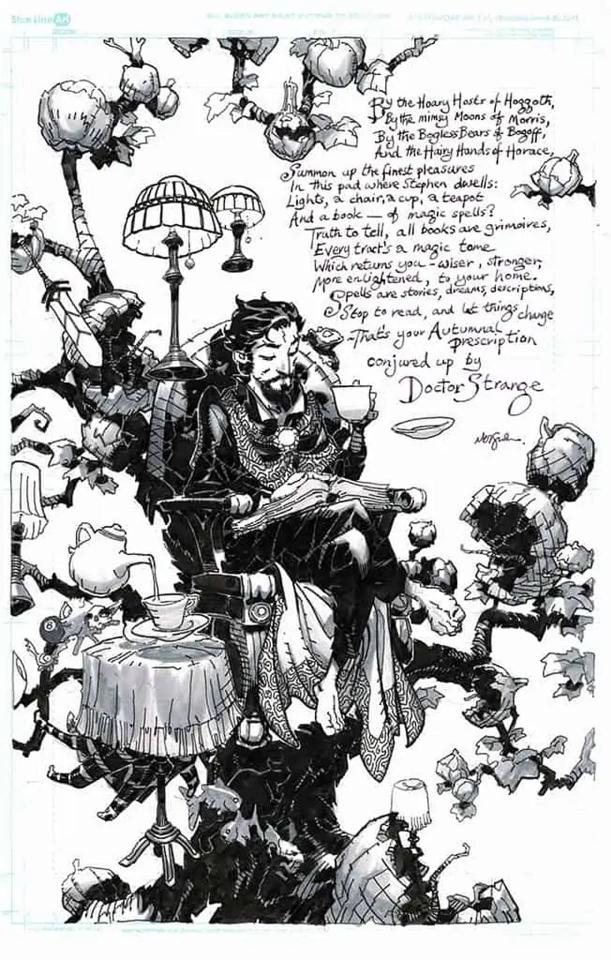
...and one from the 911 Benefit book...

You are in charge. You can do whatever you want. The Hill Wife is in the public domain. Have fun retelling it.
1K notes
·
View notes
Text
I'm crying laughing, the DVDs are even worse than I remember... Season 1's menus are silent with a single static jpg of the same key character art they use for everything else, and the episodes on the Season 2 discs don't even match what's listed on the box! Absolutely stunning lack of shits given. Truly unparalleled. But I really shouldn't be surprised given... well... everything about how this series has been treated since the very beginning.
Time for a quick ~✨PHANDOM HISTORY LESSON✨~ to give newer/less hyperfixated folks more context for why the graphic novel being as great as it is is such a HUGE deal:
Danny Phantom was one of Nickelodeon's MAIN cartoons, in its time. It was a central pillar. One of the top three or four of their lineup, which is saying something when the competition includes the cultural juggernaut that is Spongebob.
Despite this, and despite its superhero theming making it perfectly marketable, it got basically ZERO official merch.
What little we did get was often ugly and very, very cheap. The dedication at the start of the graphic novel that jokes about collecting the Burger King toys? That's because it was some of the most notable merch the franchise EVER had. (I sadly do not have any of it. There was no BK in my hometown. Here's a pic from the internet, though, to give you an idea.)

If you think I'm exaggerating about that being the most significant physical merch to come out of the series, consider that the first video game had an entire menu option specifically for the Burger King promotional tie-in:
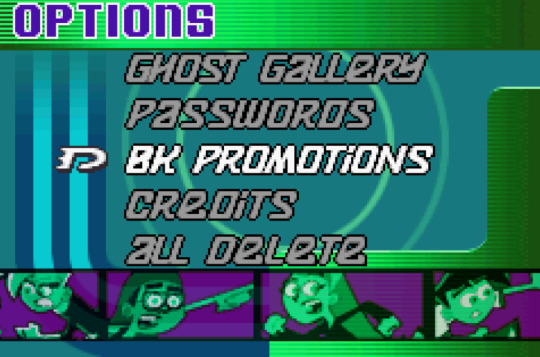
That video game, by the way, was one of only two ever based on the show. The first was an adaptation of "The Ultimate Enemy" in the style of a short sidescrolling beat-em-up, and the second was themed around "Urban Jungle" and (as far as I can tell--I've only played the first couple levels) was an arcade-style scrolling shooter. Both were for the Gameboy Advance, and both are...... fine, as far as cash-grabby video game tie-ins to kids' shows go. This was pretty normal for the time, so I suppose we did okay in that department, actually. They're not GOOD, but they're playable and have at least a bit of effort put into them.
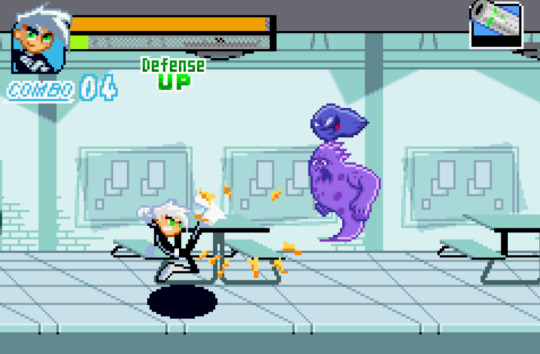

But besides those two video games (plus a handful of simple, long-defunct Flash games on nick.com)? In the decade and a half since the show ended?
Nothing.
No books, no games, no comics, no web shorts--unless you count mega-crossovers with every other Nicktoon (a la Nicktoons Unite), or soulless promotional material like "Fairly Odd Phantom" (which, trust me, despite being the first new DP animation in over 10 years was not even worth the effort of watching).
...I think there was a limited edition FunkoPop once?
So yeah.
A Glitch in Time is not just the first cool, well-made thing we've seen from the franchise in a while. It's the first THING we've seen since the show. PERIOD. And arguably the first worthwhile supplementary material to EVER come out of the show, depending on how you feel about those GBA games and the Nicktoons crossovers.
This franchise is widely beloved even now, almost 20 years after it first aired, and it feels like that fact is now, finally, FINALLY getting some official recognition.
PLEASE read A Glitch in Time. Tell other people about it. The series--no, the fans--deserve this (and more of this, if the folks in charge see enough of a response and decide to grace us with any followup). It's LONG overdue, but better late than never.
#Danny Phantom#this is why I've been losing my mind repeating ''please buy it'' over and over btw#this is the FIRST and maybe ONLY time we'll ever get to directly show support for the series#it is a uniquely huge deal for this fandom#it's totally fine if you can't (or just still won't) buy it of course but I am begging folks to consider it IF they can.#not for any moral guilting or anything just.... for me. for the fandom. (for yourself because it's a cool story lmao)#long post
534 notes
·
View notes
Text
Dead End is over.
I had hoped I wouldn't be making another post like this, but here I am. This is what I woke up to:

Credit: @hamishsteele on Instagram
To say I was heartbroken would be an understatement. I'm not just broken-hearted; I'm out of hope. Hope that Netflix will treat animation and its creators with the level of respect that we deserve, hope that we might actually get closure for a story, hope that a show I love gets to live on, hope that any series will be able to make it past a season or two before being unceremoniously axed by the rat bastards in charge. First Inside Job, now Dead End. When we lost Inside Job, I was incredibly worried that Dead End would be next. God, I wish I'd been wrong. And after all this, after what Netflix keeps doing, and after the absolute nightmare of the WBD Purges, what's the point of getting invested in a show and the characters if it's just going to get cancelled because of "not making enough money"? Dead End had so much that made it an incredible show! The characters were all lovable and incredibly relatable, it was a show for all ages to enjoy but was unafraid to get darker when it needed to, incredible plot twists, a fascinating world and compelling supernatural hierarchy, fantastic queer and trans representation (especially in the leads), a gripping story, constantly STUNNING art and animation, a wonderfully talented voice cast, memorable and poignant music, and a truly heart-shattering finale that, once again, we will likely never get to see continue onscreen. Because of Netflix, we're left with a perfect show feeling incomplete. All it would take is one more season. Just. One. More. And they don't even have the decency to allow that. I loved this show. So, so much. I still do, and I will until the end of time. I'm grateful that at least the graphic novel series it's adapted from is getting its third and final book, and you'd better believe I'm buying the Deadendia books the moment I'm financially able to. We just deserved a proper ending to the show on the screen. Hamish and the cast and the crew deserved it, not the shitty hand that Netflix dealt them. I'm going to miss this show so, so much. I already do, honestly. Thank you, Hamish and everyone, for bringing this show to our screens and to our hearts. I love you all, and I am beyond grateful I got to experience what you made. Thank you.
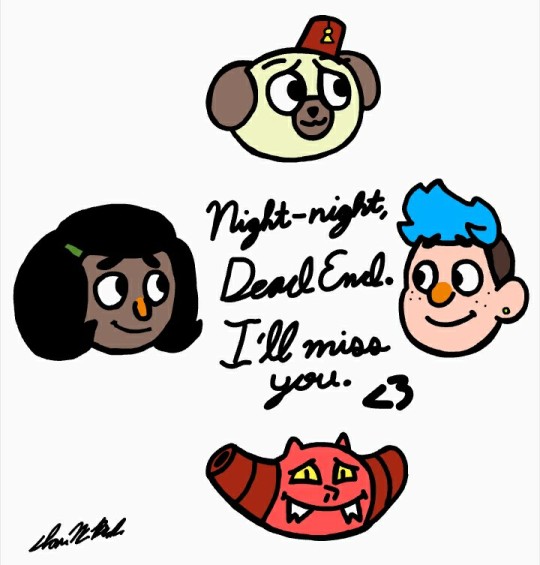
Credit: Myself
To Netflix:
You are our Frankenstein. And we are your monsters. F-ck you.

Night night, Dead End.
#dead end paranormal park#dead end#dead end netflix#save dead end#renew dead end#seriously netflix?#you just killed off inside job FIVE days ago#hamish steele#barney dead end#norma dead end#pugsley dead end#courtney dead end#badyah dead end#logs dead end#pauline phoenix#i'm not okay#we deserve closure#fuck netflix#i'm going to miss them so very much#de:pp#dead end cancelled#thank you for all you've done for us crew#night night barney
81 notes
·
View notes
Text
You guys may be tired of seeing me say the same thing all the time, but what the heck, WD is basically the second main topic of this blog.
I really can't stand to see the tag and find people always talking about the movie as the main medium, ignoring the existence of the original book and referring to other adaptations as "remakes" or similar (I saw someone referring to the Graphic Novel as "Novelization" as if it was adapting the movie lmao).
And maybe it wouldn't bother me if it wasn't the same movie that gave this story that reputation of being about "bloody bunnies". I read an analysis someone did a while back that I strongly agree with. Saying how the movie preferred to go for the basics of horror by adapting the scary/gory scenes concentrating on pure shock instead of trying to go deeper into why those moments are distressing to the characters. While it's true that explaining something with words is not the same as seeing it directly represented, the animated format at least gives more depth to the characters. For example, something this person mentioned is that the scene of Fiver falling in anguish during Efrafa's attack does not give the same feeling as in the book. In the book the scene is really scary because of how Fiver to talk nonsense and not to mention how he manages to practically traumatize several soldiers to the point of making them run away and/or surrender to him.
While in the movie you only have a rabbit in a state of epilepsy emitting strange moans that manage to half disconcert a couple of soldiers only for them to immediately ignore the issue and go on with their own thing.
Or the famous dog chase scene where the angst and tension on the part of the rabbits in charge of guiding him is left aside to concentrate on animating the massacre of soldiers in detail.
It may also have to do with the practical lack of personality and background of most of the characters except Bigwig, Hazel and Fiver (and with these two I still have my doubts). Woundwort has no backstory so here he's just a bad, wild rabbit only because yes, for example.
They always come out with this "bloody bunnies killing each other" thing when, ok. It's true that in the book the rabbits seem to have the option to kill as something relatively normal, at the same time in the novel it's shown how it's not really the first thing they think of when faced with a threat. Usually before thinking about killing (except for particularly aggressive rabbits) they always go to dialogue. More aside most deaths of one rabbit to another, if not incidental/provoked by a third party (ahem, the fox, the wire, the dog, the train), are executed by a rabbit seen as "bad" and not something that is particularly praised.
Does it sound like I hate the movie? Not really, I appreciate it even with everything. But I do hate that the vision it gave to this story was not the best. You can justify to me in a hundred ways why the movie is fine the way it is or that you like it, but I'm sorry, my opinion on this is going to remain the same.
By the way, if you want to read the analysis I mentioned above here it is.
It explains the whole thing much better than I ever could:
https://ravingsanity.wordpress.com/2015/02/14/a-series-of-uncorrelated-events-watership-down-and-how-it-relates-to-adaptation-theory/
8 notes
·
View notes
Text
127. The Librarian of Auschwitz, by Antonio Iturbe, adapted by Salva Rubio

Owned: No, library
Page count: 120
My summary: Dita is fourteen years old - in Nazi Germany, that's old enough to be imprisoned, if you're Jewish. But even in Auschwitz, there is a small bud of resistance. Fredy Hirsch, a Jewish leader, has managed to save eight books and smuggle them into the camp. Dita, charged with their care, becomes the Auschwitz librarian. For all it's hell, life is almost bearable...for a time. But the hand of the Nazis will come down once more, and threaten to break apart all the survivors have built.
My rating: 2/5
My commentary:
I often peruse the Secret Shelf Of Graphic Novels at work, down in the fiction reserve and not accessible to the public. This one is based on a prose fiction book (that I haven't read) which is itself based on real events - the story of Dita Kraus, adapted as Dita Adler, a young Jewish girl who was deported to a concentration camp in 1942, at the age of 13. She was sent to Auschwitz a year later and placed into a 'family camp' that was used as a show camp, to fool the Red Cross and protecting powers into believing that Jewish people were not being murdered in the camps. During her time there, she managed a library for children; they only had a handful of actual books, but they tried their best to give the children incarcerated there the best opportunities and education under the circumstances. It is, as with anything discussing the Holocaust, a sad story. So how did this adaptation-of-an-adaptation do at telling it?
(Warnings for Holocaust-related material like anti-semitism and murder under the cut.)
Not…so well, as it turns out. Just as a disclaimer here, I have absolutely no doubt of the real Dita's story and do not wish to imply it is untrue, any criticisms I give are intended to purely be criticisms of how this particular story is portrayed. And my main problem with it is that there wasn't really any detail - it felt like it was giving an overview of the story rather than delving into it at any point. There isn't a lot of space to develop many of the ideas it brings up, and it feels like we rattle from beat to beat without letting any of it sit for any amount of time. It's also very clean, for a story about the Holocaust? I get that the 'family camp' in which Dita was incarcerated did initially treat its inmates better than the rest of Auschwitz, and that the true horror came later when the inmates had outlived their 'usefulness' and were massacred, but the art overall did seem to portray a remarkably more sanitised image of a concentration camp to what I was expecting. I don't think the graphic novel was bad? It was just…functional. It told the bones of its story, but didn't really go too in-depth with it. And that wasn't as satisfying as I would have liked.
Next up, something similar - two men who survived the Holocaust at all odds.
2 notes
·
View notes
Text
Six-Fic Six-Sentence Sunday
Hi all! Fics below the cut.
I know I don’t use this blog ‘properly,’ but I wanted to try one of these preview posts at least once as a form of self-motivation! I haven’t been able to read or write as much as I’d like this year, but I think that’s finally turning around!
Stay safe out there, everyone! Be seeing you!
Cyberpunk: Xadia
T+ // Sci-fi AU, aged-up characters. Roughly based roughly on TTRPG Cyberpunk setting, and now some video game as well! A sequel to the 2020 Birthday Bash chapter
Rayla lets Callum a little further into her life, and its details start connecting dots in Callum’s memory. The two work to uncover her past, in spite of both gang law and corporate policy.
===
The crowd surged as Rayla stepped into a small spotlight alongside the vocalist, her guitar swinging wide as its now-distorted notes ripped through the charged room. The frontman reared back, microphone raised, and howled with redoubled energy.
“Hunt down- hunt down- hunt down- your self-esteem!”
Then the lyrics were all but lost in the anguished roar of Rayla’s solo, and Callum winced, electing to cover his ears and stay in the crush of bodies to keep from losing sight of her. She wasn’t watching the crowd, wasn’t watching her hands, only mournfully sweeping her eyes along the edge of the stage, her mouth twisted in a grimace as she played.
Vollarian’s Day
T+ // Very Late Valentine’s prompts.
A mix of canonverse / other AUs, to follow the Rayllum Valentine’s prompts from earlier this year (2021)
Excerpt from Chapter 1
===
“So what’s the book for?”
“Oh,” Callum perked up, reaching for the sizable tome, “just a little… story, I guess, that made me think of you. Of us.”
She eyed the book in his hands. “That looks pretty substantial for a ‘little story.’”
“It’s a collection! They’re not bad, but… here we go- ‘Vollaria’s Everlasting Ardor.’ This is the one.
Rayla’s ears twitched at the name. ‘Vollaria’ didn’t exactly sound… human.
“This isn’t one of the stories with the shirtless men on horses, is it?”
Untitled ‘Edge of Tomorrow’ AU
M+ // Xadia AU (?), major character death, potential graphic violence. Based on the concept of the Japanse light novel “All you need is kill,” which was adapted to the hollywood film “Edge of Tomorrow,” this is a not-so-nice time loop story.
Since a certain someone brought it up a long, long time ago...
When the seemingly-random minor devastations began, the pentarchy could do little besides disregard them as magical events of the world. Now, several months into a shaky alliance with Xadia, the military might of both factions is near-spent attempting to contain what the Elves have guaranteed is a calamitous threat. A lottery is drawn to determine which unlucky souls will be sent to the next expected target...
===
The last thing Callum could focus on, as his vision darkened, was the moon over the elf’s shoulder. Visible in the daytime despite the glare of magic light from nearby. Its surface rippled as if liquid, like a drip into a bucket- some trick of death, he was sure…
∞∞∞∞∞∞∞∞∞∞∞∞∞∞∞∞∞∞
And then he was breathing again- huge gasps of air, forcing his lungs to work again -but they were fine. He was fine. Sitting up in his bed in the castle, the chill of early hours again settling around him like morning dew.
Drought
T+ // Canonverse Non-Rayllum side story related to the fighting soon after the breach was opened. What happened to those that inhabited the lands close to the world was torn open? A one-shot relating the tale of a human that fled the fighting on the Xadian side of the border, who happens across an earthblood elf’s forest, dying as it is too close to the breach.
===
“Even a small amount is enough.”
She watched the human ignore her cupped hands, opening his canteen and carefully pouring a tiny measure of water into its cap- less than she’d hoped, but more than she’d dared believe the man would ever give her.
When she took the offering back to her Tree, pouring the water over its single exposed root, the human roused himself to anger once more.
“Hey! What do you think you’re doing? We both need that more than your dead tree!”
Already beginning to feel the slight reinvigoration of the water, Milyn offered the vessel back. “Not dead.”
The cap was snatched away, but only secured after the man took a greedy swallow of what precious water was left to them.
Untitled Minority Report AU
T+ // Modern Sci-Fi AU (Yeah, again) Another AU based more closely on the Minority Report movie than its 1950s short story source.
Prediction of the near-future is now within reach of the modern world, and law enforcement has successfully used it to prevent violent crime, including murder. For Rayla, an officer of this division, it’s a slow day of monitor-watching… until it isn’t.
And yes, pink hair as requested.
===
“He’s still out on that farm?”
Rayla was already pulling on her street jacket and lense-ordering a dropcraft to the address Callum had given her all that time ago. “Far as I know.”
“Rayla?”
She turned. “Yeah?”
“Promise me you won’t run.”
Soren’s face slackened into a deadpan as she hesitated, not saying what they both knew, and Rayla shrugged before leaving him alone in the control room, spinning the prediction’s truecopy between his hands.
Already Dead
Undecided rating // Xadia ‘low fantasy’ AU. This is the... ninth iteration of the very first fanfic I ever wrote, starting in April 2020. Its timeline, story, and characterizations have been rewritten so many times, but I feel like this might be the right story I want to tell? It’ll be my love letter to the fantasy genre that helped me so much in my life, as well as the fanfic world I’ve grown to love.
Callum embarks on an elf-supervised pilgrimage to research primal alternatives to dark magic, while Rayla comes to terms with what being an assassin entails.
===
“What did he do?”
Runaan’s eyes narrowed. “His crimes have been committed, and his guilt recorded. All that’s left is his justice.”
Rayla looked away from the glare, down at her hands, reciting what she knew would please him. “Assassins don’t decide right and wrong, only life and death.”
“Just so.”
She swallowed the rough lump in her throat.
“I’ll do it.”
19 notes
·
View notes
Text
Why Not Spend Your Lock-Down with Dr. Hannibal Lecter?
By Shannon L. Christie
You are cordially invited to spend your lock-down, dining in the company of Dr. Hannibal Lecter.
Menu
Reception
Dr. Hannibal Lecter is one of thee most iconic fictional literary villains, created in the 20th Century; Hollywood films has cemented his iconic status and his transformation into the 21st Century, via network television, has been carefully crafted under the watchful eye of executive producer, Martha De Laurentiis.
Hannibal Lecter sprang from the mind of novelist Thomas Harris; Lecter has been in our lives for almost 40 years; introduced with the publication of Red Dragon in October 1981; he has never left our consciousness for too long.
So where does one start?
Do you read the 4 novels, watch the 5 movies or the TV Series?
Do I start at the beginning with Harris's novel, Red Dragon?
There are several ways to feast upon Hannibal Lecter: read Harris' novels first: watch the movies and then dine on the TV Series; read the novels, watch the corresponding movies and then the TV Series; watch the TV Series and then go back, watch the movies and read the novels. Whatever way you decide, you will not be disappointed at the end of your feast!
The following menu outline would be my suggestion for how to feast upon the sumptuous offerings of Dr. Hannibal Lecter.
Amuse-bouche
In this course we are served small bit-sized morsels of Dr. Hannibal Lecter.
Red Dragon: Thomas Harris, 1981
Will Graham, a former FBI Special Agent with an instinct for profiling, is sucked back into consulting for the FBI on their latest serial murder case; involving the Tooth Fairy. Will's been living a quiet life in Florida with his wife and son, when his former boss, Jack Crawford visits, enticing Graham back into the game. In order to get that old scent back; Graham needs to get into the mindset of a killer, so he visits Dr. Hannibal Lecter at The Baltimore State Hospital for the Criminally Insane, where Lecter is serving 9 consecutive life terms for murder. Graham was the FBI Agent who finally caught Hannibal and it almost cost him his life and sanity.
Interesting Fact: Harris attended portions of Ted Bundy's trial for the Chi Omega Murders in Florida. The Prosecutors in the Bundy trial used bite marks left on one of his victims as evidence. Dolarhyde left bite marks on Mrs. Leeds, which allowed forensics to create dental impressions, creating a sample of Dolarhyde's teeth.
Manhunter: Directed by Michael Mann, 1986
Manhunter was written and directed by Michael Mann; starring William Petersen (Will Graham), Dennis Farina (Jack Crawford), Tom Noonan (Francis Dollarhyde, film spelling/Red Dragon/Tooth Fairy), Joan Allen (Reba McClane) Brian Cox (Hannibal Lecktor, film spelling).
Manhunter is now considered a cult classic; at the time of it's original release it fared poorly at the box office and met with mixed reviews. It's cult status may be partially due to the continuing saga of Hannibal Lecter and William Petersen's success in CSI. The film touches on many of the important elements of the novel and also misses on quite a few. What is Dolarhyde's motive? The movie is dated with a definite 80's Michael Mann vibe; in spite of that it is definitely worth a watch for Noonan's performance.
Interesting Fact: Film Producer Dino De Laurentiis purchased the movie rights to the novel Red Dragon in 1983.
Red Dragon: Directed by Brett Ratner, 2002
This is where I'll skip ahead and talk about Manhunter's remake, Red Dragon. You can either choose to watch Red Dragon here or move it to after Hannibal to watch in order of release – entirely up to you.
Dino De Laurentiis passed on the movie rights to The Silence of the Lamb, due to the poor showing of Manhunter at the box office. So when The Silence of the Lambs was critically acclaimed by the critics; a huge box office success; winning the top 5 categories at the 1992 Oscars; Best Picture, Best Director, Best Actor, Best Actress and Best Adapted Screenplay – Dino wanted another serving of Hannibal Lecter.
When Harris released his third Lecter novel, simply titled Hannibal, Dino De Laurentiis picked up the rights and saw this as an opportunity to remake Manhunter, this time using the book title, Red Dragon, especially considering the success of Anthony Hopkins as Hannibal Lecter. In fact, Red Dragon was released in theatres a year after Hannibal.
Lecter's role was beefed up with a few added scenes; Lecter enjoying the symphony with the exception of the violinist; experiencing one of Lecter's sinfully delicious dinner parties of the music council with the violinist as the main course; seeing the tete-a-tete played out between Lecter and Graham (Edward Norton) that nearly cost them both their lives.
Dolarhyde's (Ralph Fiennes) abusive childhood is explored, the motivation for his heinous crimes against families. We see more of the relationship between Dolarhyde and Reba (Emily Watson) and Dolarhyde's struggle to keep the monster at bay. Ted Tally wrote the screenplay (he wrote The Silence of the Lambs screenplay and passed on the Hannibal screenplay); he has a great sense of what is essential to the narration of a well conceived movie, without loosing too much of the original story told by Thomas Harris.
I am partial to Red Dragon over Manhunter for that reason; I love Ralph Feinnes portrayal of Dolarhyde; he's creepy without being overtly creepy like Noonan is in Manhunter. Anthony Hopkins plays Hannibal Lecter beautifully as he always does. There are a few flaws in this version though, namely Edward Norton's portrayal of Will Graham. I love Norton – I just think he was wrong for the part and the bleached blonde hair drove me mad. I also have issue with Harvey Keitel as Jack Crawford, I just didn't get an FBI Special Agent in charge of the Behavioral Science Unit vibe from him. Keitel is the guy you bring in to rough up your suspect. On the plus side, the crime scenes are more graphic than in Manhunter, which I feel is essential to understanding the severity of the need to capture this fiend, because now he has a taste for it and he will not stop!
Interesting Fact: Dino De Laurentiis had to make a deal with MGM, so the shot of The Baltimore State Hospital building used in The Silence of the Lambs, could be used in Red Dragon, as the building had been demolished.
Dinner
Appetizer
In this course we are treated to petite, rich tasty morsels of Hannibal Lecter,
both of the hot and cold variety.
The Silence of the Lambs: Thomas Harris, 1988
The follow up novel to Red Dragon, Harris' third novel, Lecter was not a character Harris intended to use; he just showed up one day as Harris wrote. The Silence of the Lambs was the story of a young female FBI agent in training; female agents were a relatively new concept at Quantico. J. Edgar Hoover had died in 1972 and the FBI slowly started to drag itself into the modern age and out of the Mafia/Prohibition dark ages that it was founded on. Harris' story of Clarice Starling was an exploration of an agent in training along with a manhunt, headed by Jack Crawford, for a serial killer, only known as “Buffalo Bill”; who abducted girls, held them hostage for a few days; shot them in the heads, dumped their bodies in rivers; having partially skinned them post mortem. The FBI is stumped, they have no motive, no pattern and no connections between the victims. What should they do? Crawford sends Clarice Starling, an agent in training to interview Dr. Hannibal Lecter.
The Silence of the Lambs: Directed by Jonathan Demme, 1991
As I previously mentioned, Dino de Laurentiis passed on acquiring the movie rights for The Silence of the Lambs; the rights ended up in the hands of Demme and Orion Films, without a fee paid to De Laurentiis. The screenplay was written by Ted Tally, who managed to highlight all the important aspects of the novel, creating a balanced story. The movie starred Jodie Foster (Clarice Starling), Glenn Scott (Jack Crawford), Anthony Heald (Dr, Frederick Chilton), Ted Levine (Jame Gumb/Buffalo Bill) and Anthony Hopkins (Hannibal Lecter),
Interesting Fact: Anthony Hopkins on screen performance of Hannibal Lecter, consisting of only sixteen minutes earned him an Oscar for Best Actor in 1992.
Entree
This course is a hearty and meaty dish of Hannibal Lecter, served with delicate red sauce.
Hannibal: Thomas Harris, 1999
Would Harris write another Lecter novel? As we eagerly waited to see – making us wait 10 long years, Harris' reward was Hannibal; a story centred around Dr. Hannibal Lecter. I think many people weren't prepared for the monster to be uncaged. It was bloodier and gorier than the previous two films and quite sadistic. Manhunter and The Silence of the Lambs were considered psychological thrillers with a dollop of horror. Hannibal was a full on horror novel with a dollop of psychological thriller. Dr. Hannibal Lecter was free of his cage, just in-time for the new millennium and some readers were not happy.
When the novel, Hannibal, was released, many critics and readers were appalled by the goriness of it (we are talking about a man who kills people and eats them). I guess once the layers of the onion were peeled away; culture, music, art, culinary skills, courteousness – they were horrified by the monster at the centre – that was the point. Serial killers show society a veneer of acceptable personality traits; they keep the monster hidden away, until he breaks through and comes out to play. In that sense, the novel Hannibal, is spot on. He's your neighbour, your friend, your husband, your father, your brother and sometimes your son (The majority of serial killers are male, sorry guys). He wears a symbolic mask in public, to prevent you from guessing how sick and perverted he truly is.
Harris' novel, Hannibal, was the perfect GOTCHA moment! Harris had led us into a false sense of security; either intentionally or unintentionally, with Lecter's intro in Red Dragon; sure he tells Francis Dolarhyde to kill Graham's family – In The Silence of the Lamb; Lecter is so helpful trying to advance Clarice Starling's career; sure he kills several people while escaping from custody; we'll just chalk that up to acceptable carnage.
We start to rationalize that Lecter can't be all bad; he must have some redeeming qualities: he's a man of sophisticated tastes; he's knowledgeable; an incredible chef; a great musician and artist. We don't even mind knowing that he dined on Dr. Chilton, upon his escape; possibly thinking Chilton had it coming.
Harris let us peek briefly behind the curtain in Red Dragon and The Silence of the Lambs and perhaps Harris was dismayed to learn that upon the popularity of Hopkins portrayal of Hannibal Lecter; he'd become a pop culture icon and somewhat of a hero. Hannibal shattered that illusion.
We find Clarice Starling, 10 years later, working as an FBI Special Agent, in a stagnate career. She can't advance; being blocked by Paul Krendler.
Hannibal has been living in Florence as the curator of the Palazzo Capponi as Dr. Norman Fell (the real Dr. Fell disappeared under mysterious circumstances). Florence, Italy, the ideal spot for Lecter, a true Renaissance man. We discover there has been a string of murders by the fiend, know as Il Mostro.
Meanwhile, Mason Verger, Lecter's 4th victim, is on the hunt for Dr. Lecter, who left Mason disfigured, although technically by Mason's own hand. Verger has offered a $3,000,000 reward for information leading to the capture of Dr. Hannibal Lecter.
Interesting Fact: Thomas Harris attended the trial of The Monster of Florence, Pietro Pacciani, in 1994, incorporating some of the aspects of the crimes into his Hannibal novel and hinting that Hannibal himself was Il Mostro (The Monster of Florence).
Hannibal: Directed by Ridley Scott, 2001
If some readers were unhappy with the novel, there were those unhappy about the production of a movie in the same vain. Ted Tally didn't want to write the screenplay, Foster didn't want to reprise her role as Starling and Demme wasn't interested in directing. The consensus was it was too graphic and gory and they wanted no part of it; a complete turnaround; they initially were chomping at the bit to be involved in the follow-up to The Silence of the Lambs.
Interesting Fact: Dino De Laurentiis was under the impression that given a good story even he could play Clarice Starling.
The extra dinner course you never needed; you were already full.
Hannibal Rising: Thomas Harris, 2006
From all accounts that I've read, Harris was gently coerced into writing Hannibal Rising. Dino De Laurentiis wanted an origin story to turn into a film and he'd do it with or without Harris. Harris eventually caved and produced the fourth Lecter novel, Hannibal Rising.
Harris uses the hardships of WWII as the starting backdrop for the development of young Lecter's transformation into “Hannibal the Cannibal”. This is perhaps a story that never needed to be told. We were given glimpses in the novel Hannibal that never made it into the movie and perhaps that was a mistake; not seeing the humanity in Hannibal before events unfolded to create a monster and he is a monster, however refined his tastes are. It would have made a good contrast to the harshness of Lecter's grotesque and sadistic actions in Hannibal; that's where a good screenplay, might have made a difference. Francis Dolarhyde, Jame Gumb and Hannibal Lecter weren't born evil, they were shaped and moulded by their harsh experiences as young, innocent, impressionable children. Monsters aren't born, they are made – the moral of the stories. The difference being Hannibal always took responsibility for his actions, never placing the blame at someone else’s feet.
Hannibal Rising: Directed by Peter Webber, 2007
This time Harris would be involved, writing the screenplay for the Hannibal Rising movie. While I enjoyed Gaspard Ulliel as a young Hannibal, I felt that the story was unnecessary.
And just when you thought that was all and Hannibal Lecter's story had been narrated from beginning to end; Lecter was resurrected in 2013 for Bryan Fuller's TV Series, titled Hannibal, for three seasons on NBC.
Dessert
A delicate balance of psychiatry, culinary skills, food porn, relationships, sex, beauty, horror
and murder tableaus, like the layers of a sinful Double Chocolate Torte.
Hannibal TV Series: Developed by Bryan Fuller, 2013-2015
I know what you're going to say; there's no way I'm watching a Hannibal TV show without Hopkins on NBC! Whether your a Cox fan or a Hopkins fan; they both played the part in their own style and both performances are top notch. Hopkins had a little more to sink his teeth into with The Silence of the Lambs; as the screen time was slightly longer than in Manhunter.
I was stubborn too! I didn't watch Hannibal during the originally airing for season one or two. I remember catching a glimpse of an episode as I was on my way out to photograph a band; I was a live music photographer for around three years, so many of my Friday nights were spent in Toronto. It was the episode with the horse and the coffin-birth, which ultimately left an impression. So in January 2015 I binge watched season one and two (26 episodes) in only two days; I couldn't stop watching!
There's been a string of missing girls attributed to one person, known as “The Minnesota Shrike” and the FBI are struggling for leads. Upon the eighth girls disappearance, Jack Crawford (Laurence Fishburne) walks into Will Graham's (Hugh Dancy) classroom to request his help. Graham has the unique ability to empathize with narcissits and sociopaths and as he states, it has less to do with a personality disorder and more to do with an active imagination. Dr. Bloom expresses her concerns to Jack Crawford about using Will Graham for his special gifts and recommends keeping an eye on him; suggesting a colleague of hers, Dr. Hannibal Lecter.
Bryan Fuller's adaption uses Red Dragon as the main source material, with additional material from Hannibal and Hannibal Rising; expanding characters stories and switching some genders to give it a less male dominated cast. Characters like Margot Verger, who were left out of the Hannibal movie are slotted back in to give the Mason Verger story more substance. Cordell, Verger's valet and cook, is far cheekier in the TV series. Dr. Alan Bloom is transformed into Dr. Alana Bloom and Freddy Lounds, once played by the amazing Philip Seymour Hoffman becomes Freddie Lounds played by Lara Jean Chorostecki, who plays her less sleazy and yet still despicable.
Interesting Fact: Bryan Fuller incorporated some of the forward written by Harris in Red Dragon about his experience writing the novel.
Whipped Fresh Creme & a Cherry On-top!
Hannibal Fan Fiction
Season 3 of Hannibal ends on a cliff hanger and unfortunately NBC cancelled the show without a resolution. Not to worry, there is a buffet of Hannibal Fan Fiction out there for you to sink your teeth into. Hannibal fan fiction spans the spectrum of General Audience to NC-17 to pornographic; there is something to suit everyone's taste. If you don't find anything pleasing; you can always write your own fan fiction!
Interesting Fact: Some of the cast members have read Hannibal fan fiction.
Hannibal Fan Art
The amazing thing about the Hannibal fandom, whether you're old school or new school; there is incredible artwork to explore created by incredibly talented artists.
Interesting Fact: Bryan Fuller and the De Laurentiis Company are not dicks about copyright infringement, when it comes to fan art and fan fiction.
Hannibal Conventions
Red Dragon Con by Starfury: An all Hannibal Con in London, England.
Fannibal Fest: An all Hannibal Con with location tours in Toronto, Canada.
Sofa-Con by Fannibal Fest: Due to the lock-down situation around the world because of Covid-19 all conventions were cancelled in 2020. Fannibal Fest set of some Zoom meetings with guests that starred or worked on Hannibal.
There are several Hannibal fandom groups all over different parts of the world; who meat-up to dine and discuss their favourite topic, Hannibal. I am part of a GTA Fannibal group that centres around Toronto, Canada and we’ve met several times.
So, as we finish our dining experience with Dr. Hannibal Lecter; we'll eagerly anticipate another invitation to Lecter's dinner table, as a guest or if you're unspeakably rude, perhaps you'll be the main course; either way I'll meet or eat you there!
Shannon L. Christie
aka Hannibal_Obsessed
#hannibal#fannibals#hannibalobsessed#hannibalthecannibal#madsmikkelsen#hanniballecter#theofficialmads#thisismydesign#willgraham#hughdancy#anthonyhopkins#the silence of the lambs#red dragon#hannibal rising
14 notes
·
View notes
Text
BATTLE ROYALE: MANGA
Newsarama’s article on Battle Royale manga and an interview with editor Mark Paniccia and adapter Keith Giffen.
Originally published on Newsarama’s website in 2003.
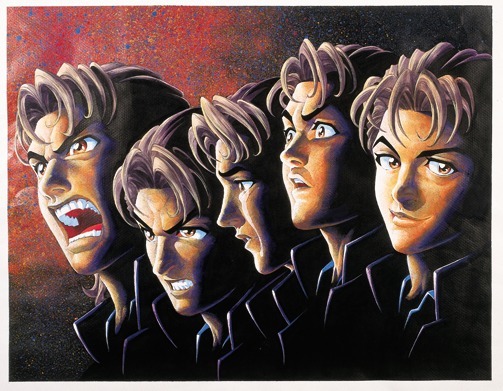
The five stages of becoming a warrior on The Program.
In May (2003), Tokyopop will shrug off the image of a company that mainly publishes shojo manga with the debut of Battle Royale, the manga based on the highly controversial novel and movie. Newsarama spoke with editor Mark Paniccia and adapter Keith Giffen for more.
First things first, make no mistake. Tokyopop is publishing Battle Royale with its 'Mature Ages 18+' advisory on it. It is not for anyone under 18, and even some readers over that age will find it a tough read.
Combining themes from Lord of the Flies and The Running Man, creator Koushun Takami wrote the novel Battle Royale in 1999. The novel was then adapted into a movie by the late director Kinji Fukasaku and has spawned legions of fans. Takami went on to write the manga of the same name, collaborating with artist Masayuki Taguchi. The series is still being published in Japan.
▼ READ MORE ▼
The novel, movie, and now manga have polarized readers in Japan, due to the manga's content. In a nutshell, the "Battle Royale" itself is "The Program," a television show in a morally and sociologically bankrupt, Stalinistic future that picks random classes of 9th grade students and puts them on an abandoned island for a televised fight to the death.
The future depicted by Takami resonates with a 1984 (or current-day America, depending on your viewpoint) feel - the students who are enlisted into the game are doing their patriotic duty, and the state is very proud of them and their "willing" sacrifice.
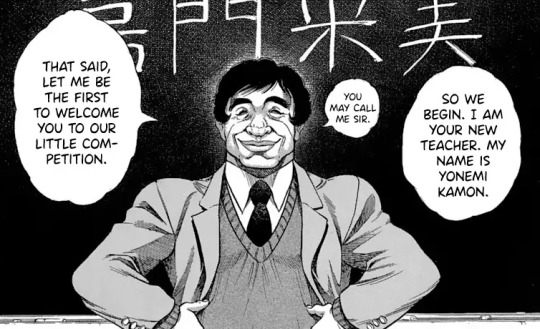
Mr. Kamon - administrator of The Program
The island is divided into grids, and the students are all given kits, which include one weapon, as well as the basic necessities, such as first aid, a compass, a map, field rations, and water; and explosive collars which detonate if a student tries to escape or goes into a forbidden grid. The beaches of the island are guarded by soldiers, and from time to time, random grid squares are declared danger zones, and after a given time, the explosive collars of any students in the square will detonate. If the students band together, after a period of 24 hours with no kill, all the explosive collars will detonate. Forty-two students begin the game, last student alive at the end of three days wins.
Battle Royale's editor knows what you're thinking. "You're right, that's pretty depressing," Paniccia said. "But the themes that play throughout it - friendship, trust, loyalty, faith - keep you glued to the page because you can truly relate to some of the stuff the teens are experiencing.
"We can all remember having a crush on someone, or wanting to be like the cool guy, or having a friend who stood up for you. Now you're thrown into a situation where you have to kill the girl you like, or the guy who stuck up for you or the kid you admire and that's where you really get drawn into the series."
In the first installment, students who stand up against authority of The Program are killed, alliances are formed, and despite the hopelessness and virtual nilhism of the story, a sense of optimism sneaks in - maybe the story's two protagonists will beat the odds and will both come out the other end alive.
It's a unique story, and that was one of the things that made Tokyopop want to bring it to American audiences. "I can honestly say I've never seen anything like it before," Paniccia said. "It's a really strong story with strong messages and it's not afraid to use really, really strong images. Tokyopop wanted to publish something that would strike a nerve. My nerves are struck."

Choices, choices...
Tokyopop isn't pushing the project out for its salacious value alone - not by any means. While, as with all product they carry, retailers will be responsible for the location and clientele allowed to purchase Battle Royale, Tokyopop is sensitive to concerns over the content. "My jaw dropped when I flipped through the pages of the first volume," Paniccia said. "I'd have to say I was more than a bit concerned about the extremity of the content. But thanks to Keith's experience and his compulsively creative mind, the adaptation of this book is in good hands."
That's not saying it's cleaned up or sanitized for American audiences by any means, though. If anything, Giffen delighted in aiming the disturbing nature of the story directly between the eyes of an American audience. But more on that in a minute - according to Paniccia, Giffen was a needed ingredient in the Tokyopop version of Battle Royale from the beginning, something that will hopefully allow the publisher to make a strong presence in comic book shops.
"Who else could this? In the beginning, one of the things we thought we needed was a recognizable comic book writer on the series," Paniccia said. "I figured the content would turn off the book retailers and the comic shops would be our best outlet. When I found out from Keith's Dominion partner, Ross Richie, that he was a big fan of the Battle Royale movie, I called him and we talked about it for a while. Keith's reputation for controversy and his enthusiasm for the property were the perfect ingredients. And thus, soon, people will hold in their hands the most infamous manga in history."
For adapting the work, Giffen was given a tight Japanese-to-English translation of the story, but his assignment was by no means just to tweak a translation. "I told him to do what he felt he had to do," Paniccia said. "I told him to Giffenize it."
It was a charge Giffen was more than happy to accept. "It's a good story that Takami is telling," Giffen said. "What I do is go in and make bad scenes that much worse. I loved Battle Royale the movie, and also love the manga. I just wanted to do it right. I wanted to do justice to it, and I knew I couldn't get away with doing a straight translation, because it would be horrifyingly bad.
"A lot of times when you work on Japanese books, you realize that they have a different pacing from us, and they also have different visual and narrative shorthand," Giffen continued. "For example, somebody may be looking at someone else with gossamer eyes and thinking good thoughts about them, and the word balloons will just say the person's name - over and over, or spend two pages trying to get the name out. That wouldn't play with American readers.

Deceiving a Friend.
"Battle Royale had stuff like, "I have to kill you first, because you would have killed me otherwise." The translation is right on the nose. You can't give that to an American audience. Specifically, in the scene where the wicked girl almost slices her friend's head off with a sickle - in the translation, she said, 'I had to kill you before you killed me.' No way - I changed it to 'Fashion tip, red's not your color,' as the dead girl lies on the floor in a growing pool of blood.
"There was another line, during the orientation where the students want to know what Mr. Kamon did to the lady at the orphanage. The scene of what he did is pretty graphic, and the original translation had him saying, 'Oh, I sexually assaulted her.'
"I wanted to make it worse. I changed it to, 'With the right persuasion, she was more than willing to share it around.' Not quite as literal as the translation, but it clearly, clearly expresses just how sleazy and reprehensible Kamon is. That's the way it is with all the graphic content in the book - it's there, and some of it is even of a sexual nature, but it's not like you're going to enjoy it for its own sake. It's my job to make sure you don't."
It's a tightrope, Giffen explained, that he has to walk in adapting the work for American readers. Go too far, and you can end up writing your own story. Don't go far enough, and you end up with a jumbled mess that halts the story.
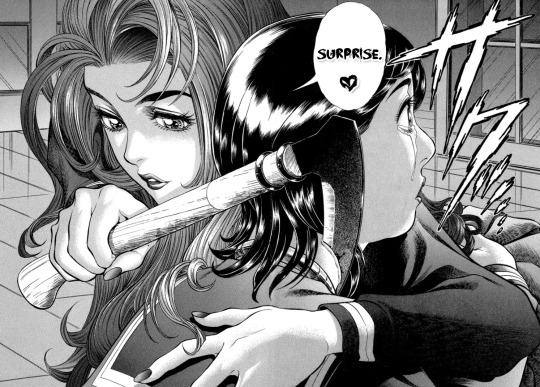
WARNING! VERY GRAPHIC IMAGE - the price of being deceived
"To do this right, you've got to keep the basic flavor of the original work - this is a guy who wrote the original novel who's doing this, so you can't go in and completely rework it and change it around, but you've got to filter it for American audiences," Giffen said. "You've got to massage it a little bit and see if you can move it just to a place where an American audience will appreciate it.
"Being able to go in there and while keeping the tone, tweaking it a little bit, I'm able to put my voice in. Rather than making it 'mine' though I'm doing a lovely two-part harmony with Takami. It's not my story, so I try to remain true to the spirit of the work. Sometimes that means dropping a colloquialism or adding blocks of copy that will allow the American audience to understand it the same way a Japanese audience would. The key rule that I always keep in mind though is: don't violate the story, don't violate the work."
But even for the creator of Lobo, Battle Royale can occasionally offer Giffen some material that is a challenge to take from simply bad to worse. "There are scenes coming up that poleaxed me," Giffen said. "This is intense shit. Brutally intense, and it does freeze me in my tracks sometimes. I'm no stranger to the gutter, but there are two scenes coming up where I had to call Mark and ask if he was sure we wanted to reprint them."
At the same time though, Giffen echoed Panaccia's sentiments on the work and how, while the violence can be frankly, distasteful at points, the emotional connection Takami creates between the readers and characters keeps you hooked.
"It's not just kids slaughtering one another," Giffen said. "It's fascinating because there's all this background there of who these kids are, and why they react the way they do to this horrific situation. For example, when Akamatsu climbs on the roof with the crossbow and becomes the game's first killer, Takami takes the time to show you why the gentlest, nicest kid in the class has become this cold-blooded killer.
"The most reprehensible acts are not by any means excused, and they're not always explained, but you see incidents in the person's past where, because of particular life experiences, characters act in certain ways when confronted with this horrific situation. It's really well thought out."

While he's able to admire the approach Takami took with the characters, Giffen also reiterates Paniccia's admonition about the series. "This is in no way, shape or form for kids," Giffen said. "This really, really is an adult comic, just due to the intensity of the content, from the ideas behind it, to the graphic depictions of the actions. There's more than just the violence, there's more than just the controversy. There's a lot of stuff going on here. It's not for kids. It's a multi-layered story. It sure as hell ain't your daddy's comics, I'll give you that much.
"But maybe it will open a few doors. My son and his friends are in the 18-19 year old group, and they're dying to see it. There's a real hunger for manga out there, and so far Tokyopop has managed to corner the female market, as well as the manga enthusiast market. Battle Royale can kick open that door even farther - it's much, much more accessible a book to the straight, standard comic book fan than a lot of other manga product out there. It's very linear, very straightforward. The art is obviously manga, but no so far out there that the American sensibility falls apart. It's going to be an interesting project. Even if it's not the most popular book they publish, it's certainly going to be the most infamous. That said though, kudos to Tokyopop for publishing the manga series of a property that the American film companies were terrified to release the movie of. It puts Warners and Sony and Fox to shame."
With the first volume due in May, Paniccia said that Tokyopop has the rights to reprint the first eight volumes of the manga, and he's planning in his adapter sticking around for the run.
"Keith seems to be having the time of his life so I hope he sticks with it for the grand finale," Paniccia said. "It wouldn't be the same without him."
And that sounds fine by Giffen. "It's a kick when you get to contribute in some way to something that you originally came upon as a fan, and just love, as I do with Battle Royale," Giffen said. "I was happy to contribute however little I could to Battle Royale, and wouldn't mind give some other manga series a try. I just wish I could get my hands on Love Hina…"
#battle royale#batoru rowaiaru#バトル・ロワイアル#manga#horror manga#gore manga#mangacap#keith giffen#takami koushun#Masayuki Taguchi#tokyopop#interview#text
11 notes
·
View notes
Text
“TDP Book One: Moon” Book Adaption Review
My feelings on the "Book One: Moon" novelization can be summed up in one word: disappointed. In a few more words: disappointed, often ticked off, and a few times, outright angry. I know that sounds dramatic. But I care about The Dragon Prince universe, possibly more than I should. I was looking forward to this book for more details about the world and insight into characters' thoughts.
Nerd rage to follow. You have been warned.
To put in plainly, the book does not read like a finished product. It needed editing…very badly. The word choice is often overdramatic, and sometimes outright wrong. The first instance that jumped out at me was in the preview of Chapter One that the staff posted on the official website:
“The rain stung [Rayla’s] cheeks [as she chased after the guard]. The putrid smell of the storm overwhelmed her senses. She’d never felt more alive.”
Here are my earlier comments on the preview. As a reader, this was not a good start, but it turned out to be indicative of the rest of my experience. Since this book is supposed to be for kids, I expected shorter sentences and simpler words; however, I also expected accurate word choice. I actually took a pencil to the page and trimmed or altered the writing as I went. Here’s another example of incorrect language, from when the assassins extinguish the lights before charging up the staircase:
“Just then, a howling wind blew through the staircase, deep and strange and oddly warm. One by one, the sconces and torches fizzled out, leaving the entire tower in sudden darkness.”
Ignoring the redundant phrasing: a sconce is the bracket on a wall that holds a torch. It is never on fire and therefore cannot be snuffed out. These are simple mistakes an editor should have corrected. Though, considering Aaron Ehasz' history with one editor at Riot Games, the Scholastic editor(s) probably did point out these mistakes. I assume he ignored them. That’s tragic, considering the people they brought in from the publishing house were either TDP fans, or had loved ones who were.
Because of these mistakes, I cannot recommend the book to anyone who is learning English, unless you keep a dictionary close by.
Another huge problem was how the book relayed information to the audience. Often the perspective just doesn't make sense. One glaring example: While in Rayla's POV, the book describes the shadowhawk arrow as though she has never seen one before, even though we know she lives with the guy who makes them. Also, she is somehow skeptical that the bindings will tighten on their own, even though she has trained with assassins for years?? What happened to “magic is all around, like sayin’ you’re in nature” (paraphrased)?! I get that Aaron and/or Melanie were trying to explain things to an audience who perhaps hadn’t watched the show, but...it would not have been difficult to phrase it differently. (It took me ten minutes tops to revise the part about the arrow.)
My final gripe is about some of the characterization. First, Viren’s perspective reads as 100% Evil Advisor Trope. I was ridiculous and it pained me. I could pull examples, but honestly I’m embarrassed just thinking about the scenes. If this is how part of writing team views Viren, the other writers and Jason Simpson made invaluable contributions to his character.
Regarding Rayla: her viewpoint seems childish. She admires Runaan, but is also intimidated by him to a degree that is unhealthy for someone of her age. She is 15. Any normal teenager is gonna start resenting their parental figures well before then – and we know how sassy Rayla can be. This may have happened in the book adaption because the target audience is younger than two out of three of the protagonists, but that can’t be all. You can pare down vocabulary and still convey nuance.
And the Moonshadow assassins…Let’s just say there were some unnecessary changes. Changes that removed Runaan’s attempt to maneuver Rayla out of trouble (thus showing how he cared about her, under the stern front), cut out some of Rayla’s agency, and made the other assassins act like bloodthirsty hecklers instead of, you know, professionals.
To be clear: I don't mind some scene and dialogue rearrangement. Prose is a different medium, and a writer needs to adjust accordingly. But this book reads less like that, overall, and more like someone decided to write their own version of The Dragon Prince’s story without anyone else’s input. Were any of the other Wonderstorm writers allowed to read the manuscript? Did anyone perform a lore check? The inconsistencies are irritating.
Visually, the book is beautiful. It has very nice illustrations and an elegant layout. We got a more detailed map, too. But all the graphic design work couldn’t make up for the disappointing and often frustrating content. The writing seemed to improve after the kids left the Banther Lodge, but not enough to overcome my accumulated grumpiness. I stopped reading weeks ago, and couldn’t bring myself to continue.
An animated TV show is a collaborative effort. The writers, director(s), visual designers, actors, and animators all contribute to the final product. Writing a book should be a collaborative effort, too, on a smaller scale. It’s not only the author(s), though they do a lot of the work. With this prose version of The Dragon Prince Book 1, it is obvious to me that Aaron Ehasz and/or Melanie McGanney Ehasz either did not seek or did not heed constructive criticism. They’ll need to start listening to their editors before I, at least, consider buying the second book adaption.
#nerd rage#tdp novel#tdp novelization#tdp novel spoilers#tdp book adaption#tdp book adaption spoilers#tdp#the dragon prince#aaron ehasz#melanie mcganney ehasz#rant#*ducks*
4 notes
·
View notes
Text
Dystopia Reading Recommendations by my friend Victoria H:
All Good Children by Catherine Austin
The American government has developed a treatment to cure teenage delinquency which is bad news for 17 year old Maxwell, graffiti artist and angry, young man. This novel is a chilling look into the future of social control using pharmaceuticals.
Angel Fall by Susan Ee
One of the few books on this list I haven’t read, but book sellers and readers alike love this series. I’m looking forward to reading how 17 year old Penryn Young survives when warrior angels attack San Francisco, beginning the apocalypse.
Children of Eden by Joey Grace
Rowan is her parent’s second child, which in a world of strict population control, makes her not just illegal but marked for death. Another novel recommended by my bookseller best friend which has received rave reviews.
Gone series by Michael Grant
I’m honestly not a huge fan of this series, but mine is definitely a minority opinion. One day, all the adults are simply gone with no explanation, leaving teens suddenly in charge of a world of children. A scary scenario which becomes more perilous as animals and the remaining humans begin to change, developing dangerous supernatural abilities.
Sixteen by Julia Karr
One of the lesser known books on this list, but one of my favourites as unlike so many other dystopias the setting isn’t also the plot. Nina is nervous about her fast approaching sixteenth birthday when she’ll receive a government mandated tattoo indicating she is now sexually available. After her mother is attacked, Nina discovers that everything she’s been told her about post-sixteen life is a horrible lie.
Legend series by Marie Lu
In the dystopian Republic, June is a fifteen year old military prodigy determined to capture her country’s most wanted criminal, fifteen year old Day, a survivor of the slums. Both think they know everything about their world, but both the hunter and the hunted will be profoundly changed when they learn the truth. The whole series is a must read.
The Hive by Barry Lyga and Morgan Baden
To rein in online bullying, the government now controls who is targeted for mob justice, and what level of punishment is deserved. Teenaged Cassie has had every reason to believe in the fairness of this system, until one online joke makes her a target of a violent punishment far in excess of her crime. Fully believable and scary; I couldn’t put the book down until I reached the end.
Bumped by Megan McCafferty
A fascinating novel of what happens when fertility is limited to the teenage years, and the competition is fierce for the privilege of impregnating the smartest, healthiest and best looking girls. Melody, who scores high on all three categories, believes she’s the luckiest girl in the world until she discovers she has an identical twin sister, Harmony, who is determined to save her from a sinful future.
The Knife of Never Letting Go series by Patrick Ness
On an alien world, a small community of human men have the ability to hear each other’s thoughts. But when soon to be 13 year old Todd discovers that the Noise of everyone’s thoughts isn’t as omnipresent as he’s been told, he’s forced to flee for his life. For there are many dark, violent secrets on this world where keeping secrets should be impossible.
Burn Mark by Laura Powell (sequel Witch Fire)
In an England where the Inquisition never ended and witches are still burned, developing the ability to do magic during your adolescence is a curse almost no one wants. Glory is determined to embrace her gifts despite them trapping her in a life of crime. By contrast, Lucas, son of a Chief Inquisitor, feels cursed by his developing powers which are threatening everything he ever wanted. These novels contain one of the more realistic depictions of the practice of magic, and of the oppressive history of British social classes.
Divergent Series by Veronica Roth
A very well known series, but unfortunately much maligned due to the declining quality of the movie sequels. However, the books themselves, especially the first two, are a compelling portrayal of a society at war with itself. I couldn’t help but root for Tris and Four, two young people determined not to allow violent prejudice limit how they live their lives.
They Both Die at the End by Adam Silvera
In this near future, computers predict with unfailing accuracy who will die in the next twenty-four hours. Two very different teenage boys receive the much dreaded notification, and as the hours pass for them, you will question with increasing anxiety how accurate the title of this novel is.
Scythe Trilogy by Neal Shusterman
On an Earth where humans have conquered death, Scythes are responsible for compassionately ‘gleaning’ a quota of people to keep the burgeoning population under control. Two teenagers, Citra and Rowan, are unwillingly recruited as apprentices. Soon, their own lives will be on the line as there’s a growing movement within the Scythedom to destroy the rules that limit their ability to kill.
Unwind Series by Neal Shusterman
And if you thought the world of Scythe was twisted, this dystopian series by the same author is set after an American civil war where the opposing sides reached a terrifying compromise. Abortion is now illegal, but between the ages of 13 and 18, unruly teenagers can be sent by their parents to be ‘unwound.’ A process that claims it allows the teen to live on in their donated organs inside more worthwhile citizens. Despite this bizarre premise, the author manages to create a very convincing and terrifying future.
The Amulet of Samarkand by Jonathan Stroud (first book of the Bartimaeus series)
In this alternative universe, the British Empire dominates the world because British magicians are able to summon and control powerful demons. When Nathaniel, a young apprentice magician, decides to summon a djinn to get revenge on his teacher, he’s immediately in way over his head. For Bartimaeus is a conniving and hilarious demon, who is often too smart for his own good. If we lived in a just universe, people would have lined up for these books like they did for the Harry Potter series.
Uglies series by Scott Westerfeld
A well known dystopian series that deserves all the praise it has received. Tally has been told all her life that she’s ugly, that everyone is until they turn sixteen and extensive cosmetic surgery transforms them into a Pretty. Tally has eagerly awaited this transformation all her life, until she makes a friend who doesn’t want the surgery as it does far more than just alter outside appearances. This whole series is well worth reading.
The Chrysalids by John Wyndham
A classic from the 1950s that’s still easily available for good reason. This novel is set in a post-nuclear war Labrador where any mutation from ‘the norm,’ no matter how small, is feared and hated. Suspect crops are burned, mutant animals are slaughtered, and any human who appears abnormal is sterilized and exiled to the dangerous, radioactive Fringes. David Storm believes he’s lucky because his differences and those of his friends are invisible. But the arrival of his sister Petra, whose telepathic abilities outstrip all of theirs, threatens to expose them all.
An Introduction to Zombies:
Zombies Versus Unicorns edited by Holly Black and Justine Larbalestier
An amazing anthology of short stories about zombies or unicorns by some of the best YA authors. Funny, disturbing and moving stories of the zombie apocalypse alongside unicorn stories like none you’ve ever read before.
The Girl with All the Gifts by Mike Carey
Told from the perspective of ten year old Melanie, the titular girl, this tense thriller takes place in a world where a fungal infection has transformed much of humanity into cannibalistic hungries. This novel tackles all the hard questions of what makes someone human, but never falters from being an entertaining and scary page turner. Also, the movie adaption is as excellent as the book.
Rot and Ruin Series by Jonathan Maberry
Fourteen years after zombies first appeared, the United States has reverted to the Old West, with small towns surrounded by the rot and ruin of civilization. Benny Imura, 15, doesn’t remember what life was like before, but wants to believe there’s more to existence than living behind tall fences and locked doors. But zombies aren’t the only dangers beyond the town’s borders. This entire series is an Intelligent, compelling and believable version of a zombie apocalypse.
This is Not a Test by Courtney Summers
Barricaded in a high school in a small Canadian town, Sloane Price and five other teens try to survive a zombie outbreak, their troubled pasts, and each other. A tense, smart thriller I couldn’t put down. Warning: themes of suicide and child abuse. There’s a sequel novella, Please Remain Calm, that I haven’t read yet, but it’s available on kindle.
Peeps by Scott Westerfield
This is smart, scary book where zombies aren’t caused by a disease, but a parasite which turns people into cannibals who hate everything they used to love. Warning: the teen protagonist, Cal, has become an expert on all kinds of parasites and describes them in graphic detail. But if you have a strong enough stomach, this is one of the most unique visions of zombies from an excellent writer. There’s a sequel that’s hard to get called The Last Days that’s shamefully still on my pile of to be read.
3 notes
·
View notes
Text
March 2020 Book Review - Books To Quarantine With

You know, when I talk about wanting more time to read this isn’t REALLY what I was talking about. Anyway, here are some of the books I read this month and/or helped me stay sane during self-isolation
Belle Révolte
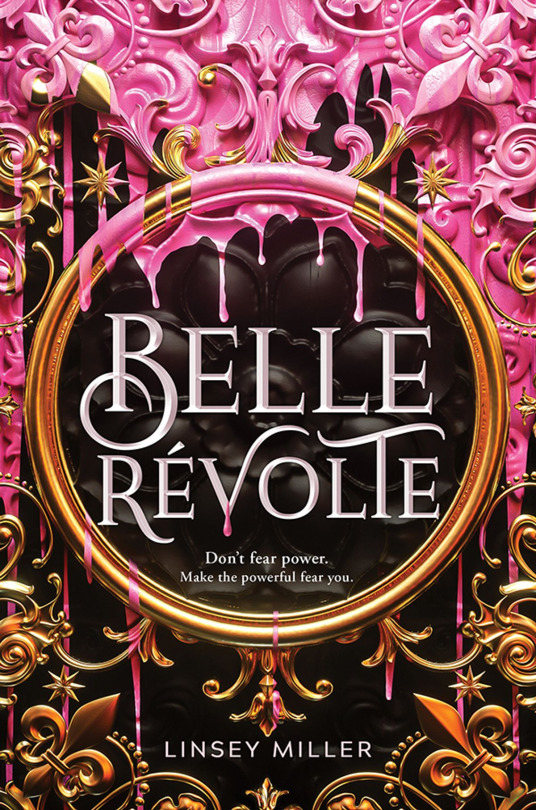
Quarantine Queer Reads! This is a book I’ve been excited about for ages, from one an author I love, and is definitely worth picking up if you like high fantasy, complex magical and societal rule systems, and queer ladies leading the charge. This was a bit of a prince and the pauper story, with the wealthy Emilie switching places with the lowborn Annette so that Emilie could run away from her finishing school and study noonday magic necessary to become a physician, and allowing Annette to take her place to study the delicate midnight magics at a wealthy school. Both end up getting embroiled in the societal and martial turmoil of their country. (Also, if you haven’t read it, go back and check out Mask of Shadows, Linsey Miller’s first duology!)
Calvin and Hobbes: Weirdos From Another Planet

Let’s be honest: this has been a stressful time for everyone. I have no idea what my job is going to look like next week, it’s a little terrifying, and sometimes you need something feel-good. So I pulled out my old Calvin and Hobbes books and have been rereading them relentlessly. As a kid, this one was always my favourite, and you know what? You are literally never to old for Calvin comics.
The Witcher: Season Of Storms
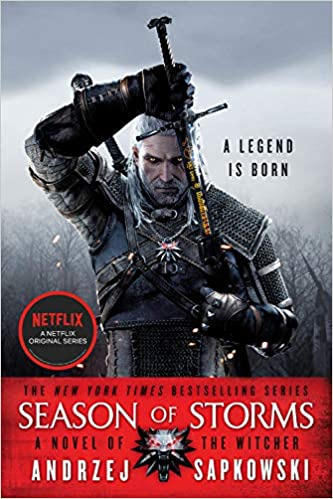
Took me some time to decide if this was meant to be read third or last in the Witcher series, but I finally decided to follow the advice to stick to chronology and read it third. I was glad I did! Season of Storms reads like a really really long short story somehow, and it was just a really enjoyable adventure. An entire plot based around Geralt losing his swords is hilarious to me, yet it managed to cram in all the philosophizing and emotion as the other stories so far. It’s a really impressive balance. Also there was lots of Dandelion trying to be helpful and Geralt Having Feelings so how can I not love it? Seriously, the Witcher novels are some of the best “classic high fantasy” novels I have possibly ever read, and they routinely make me incredibly emotional.
Sisters

A Raina Telgemeier book I hadn’t read yet. Like her others, this was a cute, heart warming story, this one focusing on families, siblings, and the importance of connection and bridging differences. I’ll be honest... not a lot of this stuck with me afterwards, I couldn’t tell you much about it now, but it was a very pleasant read at the time and the art in these books is always lovely.
Kristy’s Big Idea

Rather the same as above. It was a retelling of the first Baby-Sitters’ Club book in a graphic novel format. It was fine. I never loved this series as a kid, and I can’t say this adaptation is what made me fall in love with it.
No Fixed Address

A fantastic Canadian novel! This is a story that touches on the child homelessness crisis in Vancouver, and is about a boy who lives with his single mother. When his mother loses her job, they wind up needing to live in a van, as a web of complicated little lies weaves tighter and tighter around them. It isn’t as depressing as it sounds though! The book manages to be very goofy, light-hearted, and funny -- and over all optimistic! So while there were definitely bits that had me crying, it was over all a really enjoyable read. I would recommend, and this coming from someone who normally isn’t super into real-world fiction!
Bleach 7-9

I had taken some more Bleach books out of the library before this all hit, so I had plenty of time to get through them during this quarantine! Have to admit, these later books are a bit more meh than the beginning of the series, in my opinion. I’d never actually read this far into the series as a kid, and I can see why I stopped. It’s a bit more of a run-of-the-mill shonen fighter at this point. But I still love Ichigo and once the libraries reopen I’ll probably continue reading.
Candy Color Paradox
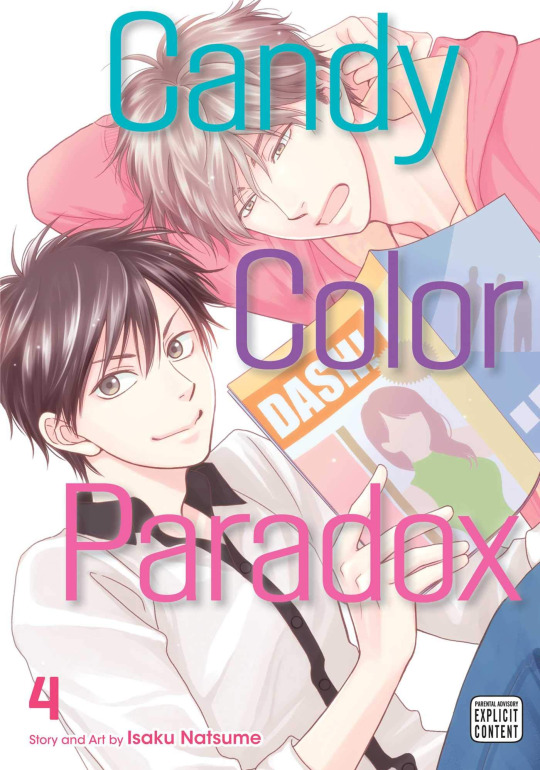
A manga that did not let me down. I absolutely adore this series -- and finding a yaoi series that actually feels like it has a really good, solid, interesting relationship is like finding a needle in a haystack. Since the couple has really already gotten together, there’s not much relationship drama in this book, and it’s more to do with the drama that comes from their jobs as reporters, and honestly it was very refreshing. I’m looking forward to the next book getting translated.
Kiki & Jax

I’d read Marie Kondo’s book, so when I saw that there was a picture book to I had to pick it up and check it out! It’s actually really cute! It’s a charming little way to introduce the importance of cleaning to children that’s a bit more relatable than just “because I told you to”, and provides some of the more practical, useful tips from Kondo’s book presented in a simple, visual format. It was lovely.
F in Exams

This is just a collection of some hilarious test answers. It takes about ten minutes to skim through but made me grin. Some are so clever you feel they should really just be given the point.
Five Nights At Freddy’s: Into the Pit

More FNAF? Yes. Listen, I’m not proud, but I was too curious after that first one not to dig deeper into this (hurr hurr) pit. This one isn’t a part of the same series, and is a much simpler collection of short stories. While Silver Eyes actually managed to be kind of intriguing and suspenseful, this was mostly just... annoying. Like bargain bin twilight zone episodes that vaguely had animatronics slapped into it. A barely dragged myself through it, and it was less than two hundred pages, though in fairness it’s also clearly written for a younger age demographic than Silver Eyes.
Deltora Quest: Special Edition 2 (volumes 5-8)
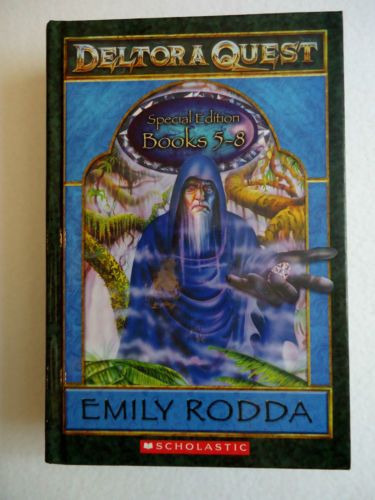
I’d read the first special edition earlier this year (books 1-4) and finally got around to finishing the series (or at least the first arc of it). Reading it as these big collected volumes is great, because it feels less like tiny little books, and more like chapters within a larger story. Honestly, Deltora Quest remains one of the my favourite series, and it did not become even a little less enjoyable to read as an adult. The characterization of the main characters is fantastic, and this author doesn’t shy away from putting her characters in truly horrifying situations that feel new and intense. Despite the premise being a classic (the characters are seeking the seven stones of the Belt or Deltora) Rodda creates really unique creatures, people, world building, and plot points.
#book review#book reviews#queer lit#canadian lit#deltora quest#belle revolte#linsey miller#season of storms#the witcher#calvin and hobbes#raina telgemeier#candy color paradox#five nights at freddy's#into the pit#marie kondo#manga#comics#graphic novels#bleach#no fixed address#susin nielsen
9 notes
·
View notes
Text
Review: The Last Smile in Sunder City


The term ‘most anticipated book of the year’ gets thrown around a lot in book blogging (I do it too, I know!) but I have genuinely been on the edge of my seat to read this since the announcement that it had been picked up – and it’s not even out until February 2020! The Last Smile in Sunder City is the debut novel by Luke Arnold, who just so happens to play my favourite character in one of my favourite shows, Black Sails (which you should totally watch). Great acting doesn’t necessarily mean great writing, so I was apprehensive, but wow, was this man blessed when they handed out creativity, because this book is absolutely PHENOMENAL.
Book: The Last Smile in Sunder City by Luke Arnold
Read before: No
Ownership: Proof copy sent free of charge by Orbit. All opinions my own.
Content warning: Violence (not that graphic, but pretty often!).
Where to start with this incredible book? It’s urban fantasy, with a noir twist, and not as you know it – though this is a gritty, dark cityscape, it’s not set in our world, and though some things seem familiar, there are deep differences from our world that keep this utterly fascinating. Fetch Phillips, our narrator and protagonist, is a man for hire – part detective, part fixer, he does the jobs no one else wants to do. When he’s hired to look into the disappearance of an elderly vampire, he becomes tangled up in something well above his pay grade…
The worldbuilding here is so fascinating. I loved that the culture was so close to our world in places – restaurants, libraries, schools, corrupt goverments – but so wildly different in others – magical races populate the world, but after a catastrophic event six years ago, the magic that sustained them is gone, and they are struggling to adapt to life without their powers (and in some cases, their life force). It’s a very dark world, full of tension and anti-human sentiment alongside the normal miserable setting you expect from the noir style. Seeing the different races jostling for position and resources is some incredible work in terms of worldbuilding – there’s a sadness and an anger in many of the characters, Fetch included, that makes the people feel very real and understandable, especially as you learn more about the last six years. But that’s not to say that this is a depressing read – there’s humour, and hope, and determination, which keeps it entertaining and on the right side of bleak. For all I’ve gone on about the darkness of the world, it’s a genuinely fun read – a difficult line to walk, especially for someone like me who doesn’t like grimdark, and it’s done incredibly well.
I loved this. I loved it. It’s smart, adult-feeling fantasy that does things I’ve never seen before. It’s amazing that such a broken world with such broken characters can be so full of heart and so hopeful, and I’m hugely invested in how this city will carry on surviving, and in Fetch’s life. I haven’t stopped thinking about it since I read the last page – this has shot straight to my keep-always favourites shelf. It’s SO good. If you like complex moralities, incredible character insight, and unique worldbuilding, it’s a must-read. I would say read it immediately, but that’s gonna be tricky with a Feb release date so put it on pre-order and block out the 25th Feb to get lost in Sunder City.
Fetch is a wonderful character, and a perfect narrator. He’s got a classic noir voice, full of cynical metaphors and an attempt to project apathy that juuuuust hides how deeply invested he really is. He’s so cocky on the outside, which is brilliant fun, but he has hidden depths and boy are they deep. I love characters where you have to dig past the hard exterior they present to get down to their real self, and Fetch is definitely one of these – his backstory is given to us in small chunks throughout the book, and we have to piece it together to get a sense of who he really is and what he’s been through. I wish I could talk more about how cleverly this is done, but it would be hugely spoilery, so you’ll just have to take my word for it. As Fetch’s history is unravelled, it gives you more and more insight into his present actions, so I’m already itching for a second read to see what I missed the first time around.
In fact, you know what? I’m gonna break my own rule, and award the second ten cats out of five of this year. It’s so worth it! - (x)


33 notes
·
View notes
Text
Dear Yuletide Writer
I am GlassRain on AO3, and thank you for writing for my tiny fandom(s)!
I love all these characters and any fic about them will make me happy. If you already have an idea feel free to run with it. If you want extra prompts or ideas, that’s what this is for.
Yes please: gay stuff, outer space, magic. Non-con, dub-con, and mind control. Relationships where there’s a power imbalance but they also truly love each other and do the work to make it good. Relationships with size differences (not as in short human/tall human, as in human/building-sized dragon). Identity porn/any kind of reveal where the audience knows something and gets to enjoy watching the characters figure it out.
No thanks: Gore/body horror/graphic depictions of violence, embarrassment, extreme underage (teen characters having sex is fine), bodily fluids (except the usual ones for sex scenes), non-canon character death, mundane AUs.
Fandoms:
Doctrine of Labyrinths - Sarah Monette
Characters: Felix, Mildmay
The Doctrine of Labyrinths is a series of fantasy novels by Sarah Monette. It is set in the secondary world of Meduse and tells the story of the adventures of the wizard Felix Harrowgate and his half-brother, former assassin Mildmay the Fox.
Lush fantasy melodrama full of codependence and great hurt/comfort. I have gotten Felix/Mildmay fic before and will keep prompting more of it until the end of time (or until a TV adaptation turns this into a megafandom, whichever comes first). Gen about them is also welcome.
Prompts:
Sci-fi/cyberpunk AU. Make the hocuses into hackers, the magical curses into corrupted cybernetics, the petty thieves into data pirates. Could be the alternate version of a canon event, or a whole new SF-themed plot twist.
Missing scene from Felix and Mildmay’s journey across the continent in book 1, something where Felix has a bad turn and Mildmay successfully calms him down. Just lean all the way into the h/c in their weird-but-deep sibling bond.
Guilty frantic brothercest. (During a time in canon when they’re both mentally capable of consenting.) Especially if it’s already an ongoing situation when the story starts, so it’s not a story about how they fell into it but about how they can’t seem to get out.
If you are up for writing crossovers: it’s a crime that there are no Labyrinth crossovers yet. How would Felix and Mildmay face off against the Goblin King?
The Murderbot Diaries - Martha Wells
Characters: Murderbot
Science fiction series about an artificial construct designed as a Security Unit, which manages to override its governor module, thus enabling it to develop independence, which it primarily uses to watch media. As it spends more time with some caring humans, it starts developing human feelings, which it finds inconvenient.
Ongoing sci-fi adventure in an interstellar corporate dystopia. Grumpy sarcastic Murderbot (it picked the name itself) just wants to be left alone to watch TV, but is smart and competent and keeps deciding it likes humans who need inconvenient rescues. No romance for Murderbot please, but go as hard as you want on the intense friendships it doesn’t want to admit it has.
Prompts:
Murderbot finds itself in charge of an impromptu So You Just Achieved Self-Determination, Now What? support group. Possible members: SecUnit Three, the unnamed ComfortUnit, original characters who hacked themselves independently and figured they were the only ones until they saw it on the news...
ART figures out that Murderbot enjoys very specific kinds of touch (low-key, platonic, comfort-seeking, non-threatening), and starts gleefully engineering situations where it can get some.
Murderbot’s love of Sanctuary Moon becomes public knowledge. Let’s see the reactions from SM fan forums, or in-universe cons, or the media company and its marketing department.
Leif & Thorn (Webcomic)
Characters: Any
Leif is a gardener in thrall to a mysterious debt, serving his native Sønheim at a foreign embassy. Thorn is a Knight of Ceannis who got severely burned while dragonslaying, and was rewarded with a cushy job guarding the embassy gates. Thorn doesn’t speak Leif’s language too well at first — but as they get to know each other, he finds a lot of reasons to learn.
Ongoing fantasy dramedy, with a cross-cultural romance and a great ensemble cast. (Read it here.) Leif/Thorn is canon. I’d love fic about them, and/or any romance (canon or not) that doesn’t break them up, and/or gen about anyone else.
Prompts:
Canon divergence AU where Thorn joined the Secret Order of Monster Hunters instead of the knights...and meets Leif while in the middle of a vampire-assassinating mission.
Holiday fic where Leif and Thorn share their traditions with each other. Warmth and fluffiness a plus.
Violet’s participation in fandom on the magic-crystal-internet. And maybe off of it, if a convention comes to town. What is magical-crystal-Yuletide like? Which series have split fandoms over badly-translated Ceannic-language dubs? Who else in the cast loves Violet’s fic without realizing she’s the one behind the pseudonym?
Tender, loving, slow-and-thorough Thorn/Kale. With Leif’s encouragement...or participation...or, depending on how you want to play it, direction.
Jeeves & Wooster
Characters: Jeeves, Wooster
Bertram Wooster, a well-intentioned, wealthy layabout, has a habit of getting himself into trouble and it’s up to his brilliant valet, Jeeves, to get him out.
Completed TV adaptation of the books by P.G. Wodehouse, starring Hugh Laurie as Wooster and Stephen Fry as Jeeves. Funny, charming, impressively complicated for how low-stakes the outcomes are. Gen or Jeeves/Wooster romance (with or without any of these prompts) all welcome.
Prompts:
Magical AU where they’re supernatural creatures – fae, elves, angels, demons, nature spirits, things in that category – and still manage to have the same dynamic, over much more ethereal problems.
Role-swap where Jeeves is a smart-but-disaffected member of the idle rich, and Bertie is a fanciful valet. Problems are solved by a mix of Bertie’s own talents and his ability to inspire Jeeves' brilliance.
Bertie discovers the fandom for his published writing (and probably needs Jeeves’ advice on how to keep professional boundaries). This can be a modern AU if you want to get the internet into it.
#yuletide#yuletide letter#doctrine of labyrinths#jeeves and wooster#Leif & Thorn#webcomics#murderbot diaries
1 note
·
View note
Text
The End of 1960s Horror...
After a few delays, we’re back on track with our jaunt through the horror decades. Last night’s films were two favorites and genuine classics.
First up, Rosemary’s Baby (1968)
youtube
The film, directed by Roman Polanski, is an adaptation of a novel by the same name by Ira Levin (the guy who wrote The Stepford Wives). I’d never read the book, and @comicreliefmorlock had read it but never seen the film, so that made for some interesting compare/contrast.
The big takeaway? The movie is so much sleazier and, well, rapey-er, despite being an extremely faithful adaptation (even down to exact dialogue lines being replicated).
This may have been influenced by the director. It’s hard to watch Rosemary’s Baby now without the film being clouded by knowing that Polanski was charged in 1977 with drugging and raping a 13-year-old (a charge which caused him to flee the country, allowing him to continue making critically acclaimed movies without suffering any particular consequences for his crime). You can read more about that here: https://en.wikipedia.org/wiki/Roman_Polanski_sexual_abuse_case
It’s also interesting to note that, a year after Rosemary’s Baby came out, Polanski’s pregnant wife and four friends were among the victims of the Manson family murders.
There’s a lot to unpack there.
But let’s get back to the movie. Rosemary’s Baby tells a pretty straightforward story: A pair of newlyweds move into an apartment and develop a relationship with the eccentric elderly couple next door. The husband is a struggling actor who serendipitously gets his big break shortly after meeting the old folks. The wife, raised Catholic and from a large family, is eager to start having children of her own. She succeeds in getting pregnant, but it’s a difficult pregnancy, and through a series of odd events, she becomes convinced that everyone in her life is part of a satanic coven of witches intent to sacrifice her baby.
Ira Levin has always impressed me with his skill at writing about women -- not just writing female characters well (which he does) but deeply understanding the fears and anxieties of womanhood in a way that is frankly surprising from a male writer in the 1960s. That shines through clearly in the film, and I can’t say for certain how much of that was influenced by Polanski -- not having seen any of his other movies, I’m not sure how he handles other source material.
Anxieties explored head-on by the film include:
Spousal rape
Gaslighting (and “hysteria” perhaps)
The loss of bodily autonomy inherent in pregnancy
Woman-as-vessel-for-baby as opposed to “whole individual person”
I could write whole essays about this movie, and I probably will at some point. The primary plot fails to shock or frighten me anymore, of course, but there are still some lingering fridge horrors that are deeply unsettling in the vein of “oh my god can you IMAGINE how it would feel to be her right now.”
Next up, and our final film for the decade, Night of the Living Dead (1968)
youtube
Written and directed by George Romero, Night of the Living Dead was a groundbreaking work for the zombie genre. Drawing clear inspiration from Richard Matheson’s story “I Am Legend,” Living Dead was an original tale that pulled together disparate strands of mythos to create many of the tropes that remain staples of zombie media.
The story centers on an event of possible cosmic origins, with radiation leading the recently deceased to rise and go on a murderous, flesh-eating rampage. Well-dressed corpses shamble about and kill. A group of strangers are stuck defending a house together, one of them is secretly infected, the group tears itself apart with infighting -- you name the zombie apocalypse trope, it’s all here.
One of the really interesting and groundbreaking things of Night of the Living Dead is that it features a black male protagonist. Now, I can’t say for certain that this is the first time in history someone made a movie about a heroic black man, but it’s certainly the earliest in our chronology that we’ve seen. And Ben (played by Duane Jones, an accomplished stage actor) is truly a great character -- resourceful, kind, brave, sometimes sassy and never afraid to stand up for himself.
The role wasn’t written for a black character -- Romero said Jones just gave the best audition -- and the film is all the better for it because it avoids all of the troubling stereotypes that would haunt black people in horror for several more decades.
In my opinion, the movie deserves a spot in history for that reason alone, but even aside from this historically significant casting choice, it’s just a good movie. A bit slow by modern standards, but with plenty of good action and some clever storytelling. Large chunks of it play out almost like a silent film, with the score and visuals doing most of the heavy lifting. The choice to film it in black and white helps to make it seem almost timeless (and likely helped to assuage the concerns of the viewing public, who were still squeamish about gore). A lot of the story is also told through snippets of radio broadcast and second-hand accounts, which adds to the claustrophobia of the main storyline while hinting at a much larger and more devastating event.
And the ending!
I remember watching Night of the Living Dead for the first time when I was in 8th grade. It was on TCM, I think, and I gleefully watched it alone in the dark and was totally blown away by the ending. I won’t ruin it in case you’ve never seen it, somehow, but man I didn’t see it coming, and cynical-preteen me thought it was the coolest shit. I still think it’s a very daring ending.

Incidentally, WOW, the post-Hayes era of filmmaking took off with a bang. A few films ago we could hardly show a married couple kissing, and now we’ve got full nudity (including an appearance from Mia Farrow’s nipples in Rosemary’s Baby), on-screen graphic violence, and “morally corrupt” endings where the bad guys win.
It must have been a wild time, growing up on the films of the 40s and 50s, and then coming of age in the 60s to see how WILDLY DIFFERENT they became in a few short years.
The 1970s are coming, and I am stoked, because we’re entering the era of movies I adore (and which the Morlock has never seen) and I’m so excited to revisit them.
#horror movies#horror by the decade#horror through the decades#zombies#night of the living dead#rosemary's baby#1960s horror
13 notes
·
View notes
Text
D-Views: The Hunchback of Notre Dame
Bonjour, mes amies! Welcome, bienvenue, to another installment of D-Views, my written review series for films produced or inspired by the Walt Disney company! For more reviews for films like Enchanted, Star Wars Episode III, and Snow White and the Seven Dwarfs, feel free to consult my “Disney reviews” tag, and please, if you enjoy this review or any of the others, please consider liking and reblogging! I look forward to writing more of these in the future for films like Wreck-It Ralph and Halloweentown, as well as Non-Disney films like Charlotte’s Web.
I recently put out a poll suggesting three Disney Renaissance films for possible review subjects, and although The Little Mermaid won that poll, this film ended up not far behind. (Thank you, @schifty-al and @mygeekcorner for your votes!) It’s one of my personal favorite Disney films of all time...The Hunchback of Notre Dame!

Victor Hugo’s classic novel Notre Dame du Paris, called The Hunchback of Notre Dame in English, seems like a very odd inspiration for a Disney animated family film, and that’s because...yeah, it is! When the Disney animators first brought Hunchback to the table, they were less inspired by the original Hugo novel glamorizing the architecture of Notre Dame cathedral, and more inspired by a graphic novel adaptation of the story, which was likewise much more influenced by the 1939 Hollywood film adaptation. Because of the historical context that 1939 adaptation was made in (premiering at Cannes during the rise of the Third Reich), themes of social justice were added to a story that originally was about how the “edifice” can outlast the flaws and sins of mankind. The “social justice” element is something that Hugo interestingly put more in his follow-up to Notre Dame du Paris, the epic brick book Les Miserables, but has since been similarly tied in the public consciousness to The Hunchback of Notre Dame, despite not existing in the original book.
The project was already an odd choice for Disney to take on thanks to the darkness of the book, but the political themes also were unique for a Disney picture as well. It clearly was a more “adult” endeavor, even though thanks to the success of previous projects like Aladdin and The Lion King, there were studio mandates demanding more comic relief, and even the marketing team was reluctant to advertise Hunchback as anything other than a family film. Rather than showing the artistry and darker scenes, the marketing almost entirely focused on the Feast of Fools and the gargoyles, highlighting the “Ugly Duckling” aspect added to the story and downplaying the more adult themes. In the end, it’s likely thanks to those poor marketing choices and the inconsistent tone of the picture that this movie failed to find its audience on first run. It only earned $21 million worldwide, compared to Pocahontas’s $29 million and The Little Mermaid’s $84 million, with mixed critical and audience reaction. Although it was nominated for an Academy Award for its music and won several others, it was noticeably less successful than other installments in the Disney Renaissance, and even now, Disney often doesn’t give Hunchback that much attention. Like Quasimodo, the film has been sort of locked up in its own tower...but now, today, I aim to bring The Hunchback of Notre Dame out of the shadows and give it the appreciation it deserves.

Our film begins in complete darkness, accompanied by resounding church bells and the amazing vocalizations of the English Opera Company, and from the very beginning, I’m just enveloped by the embrace of Alan Menken and Stephen Schwartz’s unbelievable score. Choral music in general has always been something special in my family. My mum and dad were in choirs a lot of their lives: they even first met when they joined the San Diego Master Chorale in the 80′s. Choral music remains one of my mother’s greatest loves and passions, and when I saw Hunchback, it made the choral music my parents loved so much, which focused around a faith I hadn’t been raised with and didn’t believe in, that bit more accessible to me as a child. Mum, who studied Latin in college, went on to teach me about all of the chants and phrases Menken and Schwartz added to each song so that I could more appropriately sing along. It remains one of those Disney soundtracks that cemented our close bond, and I’ll always treasure being able to see the La Jolla Playhouse production of The Hunchback of Notre Dame with my mum and getting to hear the amazing choir and instruments live.
The Bells of Notre Dame, as an opening number, cannot be matched in how it introduces us all to the story, characters, themes, and tone of the piece. In just a few minutes, the music and lyrics perfectly showcases our setting, the theme of what makes a man, the atmosphere of fear and injustice, our villain, and our hero. Menken and Schwartz previously worked together on Pocahontas, but Hunchback in my opinion easily outstrips their previous collaboration. The use of church bells of all sizes to convey the solemnity, mystery, and grandeur of the cathedral at the center of the proceedings, and the clever use of Latin phrases -- it’s just unbelievable! As one example, in the sequence where Frollo (a judge in this version, as opposed to the Archdeacon) chases Quasimodo’s mother up to the stairs of Notre Dame and she pounds on the door, crying for help, the choir sings “Quantus tremor est futurus quando Judex est venturus,” which means, “What trembling is to be when the Judge comes.” And sure enough, the line comes to a horrible, horrified halt when Judge Frollo snatches the woman’s child away and throws her to the ground.
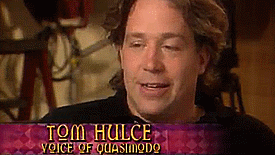
After one of the most epic musical introductions in a Disney film, we meet our sweet, gentle hero, Quasimodo, voiced by Tom Hulce, who is just such a ray of sunshine. Although I loved hearing Michael Arden as Quasimodo on stage, Tom Hulce will always be my Quasimodo. When I was a teenager, I went through a horrible “hating the world” phase where I only ever saw pain and suffering and felt not only powerless to make anything better, but worthless as well. During that time, I turned my back on a lot of the things that had brought me joy, feeling almost unable to enjoy them anymore. One of the very few exceptions, however, was this movie and especially the character of Quasimodo. When I was at my darkest points, Quasimodo never failed to bring me some light, not because he was particularly funny, but because for all of the misery in his circumstances, he never faltered in being gentle, creative, and kind. Looking back on how I’d been, I wish I’d had just a shred of Quasimodo’s grace back then. I wish I hadn’t allowed myself to fall into despair and resentment. Since I can’t go back, however, I keep Quasimodo in my mind sometimes whenever I’m going through something difficult. He’s kind of become a guardian angel of sorts to me, reminding me that my life is a precious gift and I shouldn’t take anything for granted. And really, I couldn’t do that if not for Tom Hulce and Quasimodo’s supervising animator, James Baxter. I truly am grateful to both of them for giving me a character that even now can be a symbol of everything I wish I could be.
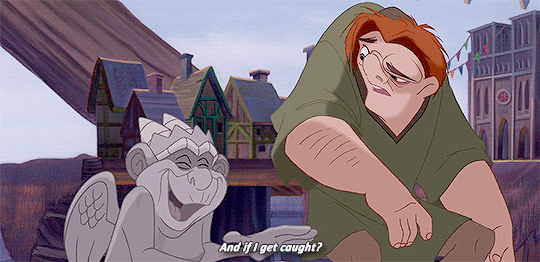
Unfortunately along with Quasimodo, we also meet the gargoyles, Hugo, Victor, and Laverne. As a kid, I actually liked the gargoyles all right, but as an adult...yeah, they really break the mood. Badly. The worst offender is easily Hugo, which is a shame because I like Jason Alexander as a performer, but he just goes way too over-the-top-obnoxious. It would admittedly not be as bad if it were clear that the gargoyles were all in Quasimodo’s head, but Djali sees Hugo come to life at one point and they later help Quasimodo fight off the guards. I greatly prefer the way the gargoyles are handled in the stage production, where all of the saintly statues have their own voices that nonetheless reflect what Quasimodo is thinking and when Quasimodo hits his lowest point before Esmeralda’s execution, he forcefully banishes them out of his head.
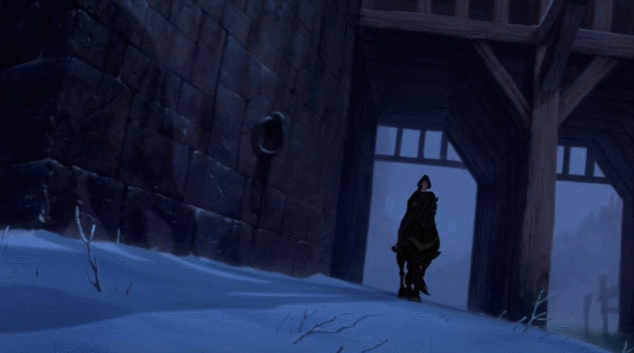
Even though the comic relief is handled poorly, I certainly cannot say the same for the villain. Judge Claude Frollo is easily one of the most evil villains in Disney history. Tony Jay’s vocal performance is just chillingly resonant, commanding your attention and making you subconsciously shrink in on yourself whenever he speaks. It makes for a despicable, cold, cruel man -- the antithesis of a father, the true embodiment of a monster. Frollo is often compared to Mother Gothel from Tangled in how they both lie to, control, and emotionally abuse their charges (Quasimodo and Rapunzel, respectively), but I personally find Frollo so much worse than Gothel, because he not only cuts Quasimodo off from everyone, but he indoctrinates a gentle, kind soul like Quasimodo in his racism and intolerance against those different from him -- including Quasimodo’s own people, the Romani. Mother Gothel hoards Rapunzel away like a dragon hoarding treasure -- Frollo treats Quasimodo like a burden, beating into him that no one else would want him and that Frollo was such a “good man” to take him in. It’s just vile.

And now we come to my single favorite Disney song of all time -- Quasimodo’s aria, Out There. From the time I was little, this song spoke to me like few others did. Growing up, I was an only child with a huge imagination surrounded almost entirely by adults and who had a lot of difficulty relating to kids my age. I often liked being on my own, but it didn’t change how I often felt different and detached from the people around me, and as I got older, that feeling only increased. I moved a lot in my childhood, making it difficult for me to plant roots, and I rarely followed trends or popular norms, so I constantly stayed in the fringes of the crowd, enviously looking on at those who could fit in more easily than I could. I always tried to hide my insecurities, but they were still there, and when those insecurities took hold, I would often imagine the world being a place where I could be myself, just like Quasi does. Quasimodo’s longing to be “part of them” and lamentation of people being “heedless of the gift it is to be them” has always resonated with me, and even though it’s hard for me to sing Out There without shifting octaves, my heart swells every time I hear it.
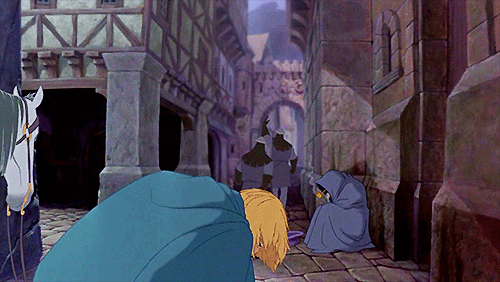
The Captain of the Guard, Phoebus, is easily the biggest liberty that Hunchback adaptations have made with the original novel. The book version of Phoebus was more like Gaston from Beauty and the Beast than how he’s portrayed here, but I frankly have no complaints. Kevin Kline is wonderfully dry and witty in the role -- he’s more than a match for Esmeralda, being brave, noble, and sarcastic with seemingly no prejudice for those different from him. And then yeah, as for Esmeralda herself...as Phoebus says later, “what a woman!” Esmeralda was one of my very favorite Disney heroines as a kid, and she still is. The character of Esmeralda is often rather saint-like in her incarnations, but here we see both the “angelic” and “demonic” sides of her -- she’s fiery, but kind; rebellious, yet noble; anti-authority, but patient; distrustful, yet loyal. In the musical adaptation, when Esmeralda is first revealed, we hear Frollo, Phoebus, and Quasimodo sing this about her --
Frollo: She dances like the Devil!
Phoebus: She dances like an angel --
Quasimodo: An angel!
Phoebus: -- but with such fire!
Frollo: Such fire!
All Three: Who is she?

This is Esmeralda’s characterization and her relationship to the three male main characters in a nutshell. Quasimodo only sees the best of Esmeralda; Frollo only sees the worst of her; and Phoebus sees her for everything she is...as a person. And this is why she ultimately chooses Phoebus, unlike in the book where she solely chooses Phoebus because of his looks.
When we reach the Palace of Justice, I’m reminded that I have yet to accent how absolutely stunning every single background is in this movie. Yes, the animation overall is wonderful, whether in the character animation or otherwise, but there are few Disney films that have more atmospheric and beautiful backgrounds than this. It serves to give the movie such a wonderful depth and makes the setting feel that much richer and deeper. Admittedly one weaker aspect of the animation is the now-slightly-outdated CG background characters. They were made by taking a handful of templates and then mixing up their clothes and colors, so as to multiply them ad infinitum and make the crowds of Paris look bigger and more colorful. Even with that, though, you do sort of have to look carefully at the background crowds to notice, as there are lots of hand-drawn characters sprinkled in in front of those CG models that help obscure their repetition and awkwardness. Those CG crowds also make the city of Paris look appropriately overcrowded and huge, so I’m glad that they used the technology even if it was still so in-progress at the time.
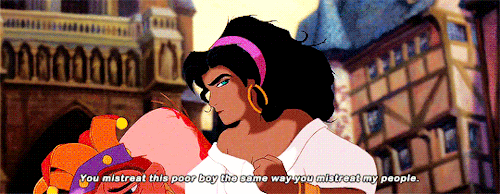
Even though Topsy Turvy starts off so fun and festive, however, it soon devolves into a terrible riot where Quasimodo is bound and tormented by the crowd. I admit, the transition is a little abrupt, but it still works for me, as people can be so easily swept away by mob mentality and those in power -- namely, Frollo’s guards -- sometimes flaunt their authority by putting down others. Fortunately Esmeralda is there to save Quasimodo and give Frollo a much-deserved verbal smackdown. The following scene, though, is another example of the mismatched tone, stretching out Esmeralda’s escape with a lot of comic “hijinks” that don’t really add anything to the film and kind of serve as a big time waster, especially after it abruptly cuts off and turns much more solemn and sad as Frollo silently confronts Quasimodo and Quasi returns to Notre Dame in shame.

Hunchback’s focus on religion is, in my opinion, one of the things that made producing an adaptation of Hugo’s novel such a bold decision. I’m not a religious person at all (Agnostic and proud), but it was still really meaningful to me to see both the good and bad associated with religion, represented by the Archdeacon and Frollo respectively. Frollo, along with Pharaoh Seti from The Prince of Egypt, taught me as a kid that evil is not always self-aware and, more importantly, how much more dangerous evil is when it garbs itself in godliness and righteousness. That’s a valuable lesson, regardless of your religious faith. God Help the Outcasts may invoke God’s name, but it could just as easily be a prayer to the world, or even just to you as an individual. The Christian faith preaches that we are made in God’s image...so when Esmeralda asks God to help her people, maybe she’s in truth asking you to try to be the loving God they need.

Something unique about Hunchback is the wonderful friendship that develops between Esmeralda and Quasimodo. From the time I was very little, I made friends with both boys and girls, so it was so wonderfully refreshing to see a story where a girl and a boy became such close friends and supported each other so much. Yes, admittedly, Quasimodo is romantically interested in Esmeralda, but when he sees how much she loves Phoebus, he both accepts their relationship and treasures Esmeralda’s friendship all the same. He doesn’t wallow in bitterness upon Esmeralda not choosing him; he loves her all the same as the first real friend he’s ever had. Esmeralda truly loves Quasimodo and treasures their friendship too -- her choosing Phoebus romantically is never framed as her teasing Quasimodo or leading him on; she simply loves Phoebus and Quasimodo in different ways. And that I find so unbelievably cool. I also like that in Esmeralda’s and Quasimodo’s conversation on the roof, there are some strains of the deleted song Someday in the instrumental accompanying the scene -- you can hear a R&B variation of Someday in the film’s credits, but originally it was meant to replace the more religious God Help the Outcasts, only for God Help the Outcasts to be chosen over it. I agree with the filmmakers’ decision, but I still like Someday too. Quasimodo’s helping Esmeralda and Djali escape Notre Dame by climbing down the towers also beautifully foreshadows Quasimodo’s dexterity in climbing down to save Esmeralda at the end of the film.

Quasimodo and Frollo are both enthralled with Esmeralda, but as mentioned previously, they each only see the angelic and demonic sides of her, which is best encapsulated by the dual numbers Heaven’s Light and Hellfire. Heaven’s Light is appropriately sweet and pure, but I can’t beat around the bush here: Hellfire steals the show, not just from Heaven’s Light but from all other villain songs in Disney history. The song starts with a choral chant praying for forgiveness, which then segways into Frollo’s demented, mad raving about his lust, fear, and hatred for Esmeralda. The words are almost terrifying in their level of conviction and paranoia, which then devolves into vindictive, destructive mania, framed by the mournful echoes for “mercy” from the choir.
Right after Hellfire, we get one of my favorite instrumentals on the soundtrack called Paris Burning. The choir’s bustling, dramatic cries trimmed by the tense strings and horns of the orchestra just evokes fear and horror as Frollo terrorizes Paris. Then Phoebus finally takes a stand, refusing to set fire to the miller’s house and then, after Frollo does it himself, leaping in to save the family from the flames. In the musical, this whole sequence is accompanied by the amazing musical number Esmeralda (which honestly, every fan of this movie should listen to, it’s really worth it), but the film handles it unbelievably well with only a short scene and an instrumental that sears the final “Kyrie Eleison” into the audience’s ears like a fire brand.
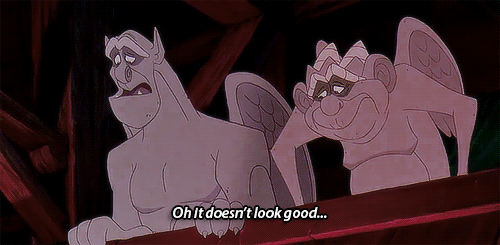
Sadly, after this amazing, epic sequence, we once again are subjected to tonal whiplash when we return to the bell tower and the gargoyles decide to sing Quasimodo a song to cheer him up. Although I maintain Hunchback has one of the best soundtracks ever recorded, what stops it from being flawless is this song. A Guy Like You is not an inherently bad song on its own, but when combined with the rest of the soundtrack, its melody, tone, and out-of-place pop cultural references are just ridiculously jarring. It’s like we’ve been transported into a completely different movie, one less inspired by a classic French novel and a critically acclaimed film about social justice and one more inspired by Disney hits of the day like Aladdin and later projects like Hercules. As sad as it is, it’s kind of a relief when it’s over and we’re brought back down to earth by Esmeralda carrying a close-to-death Phoebus into Quasimodo’s tower.
Frollo’s arrival after Quasimodo agrees to hide Phoebus is excellent in its suspense. We can sense Frollo’s suspicion, and all the while, we’re so worried for Phoebus hiding under the very table he and Quasimodo are sitting at. Then Frollo, who we’ve only ever seen as cold, conniving, and controlled, bursts into a rage the kind of which we’ve never seen before, and for a second, he’s a demon himself. After his rage is spent, he sets his cruelest, most terrible trap yet: using Quasimodo’s feelings for Esmeralda so that he can capture her and the rest of the Romani. And at first, Quasimodo almost doesn’t take the bait, thanks to a short-lived pang of self-pity. At first he’s bitter about his heart being broken and considers not helping Esmeralda, as there’d seemingly be no “reward” in him doing so...but the feeling is quelled in seconds by the memory of Esmeralda and how much her friendship means to him. Quasimodo’s selflessness and goodness wins out in its struggle with his more selfish instincts...and this, in the end, is what makes Quasimodo a hero in my eyes.
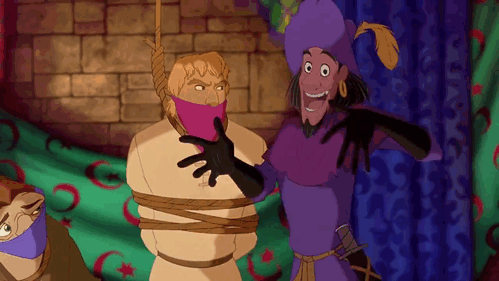
All right, I guess with our entrance into the Court of Miracles, I should address the elephant in the room. I’ve called Esmeralda’s people “the Romani” in this review, but throughout the entire film, the term is substituted for the admittedly-period-appropriate slur “Gypsy.” I knew nothing about the Romani culture when I first saw this film and I profess no intimate knowledge of it now, but even with that, I have to acknowledge that this movie doesn’t always showcase the Romani in the best light. Although Quasimodo’s parents, Esmeralda, and (to a degree) Clopin are given relative sympathy, the sequence in the Court of Miracles doesn’t do much to endear them to the audience. These victims of persecution are not really given the focus they deserve: we never learn much about their culture or about why they’re persecuted, and we don’t really get to see how they live their lives as ordinary people. To someone who doesn’t know anything about the Romani, I don’t think this film would be the best introduction to their culture and heritage.
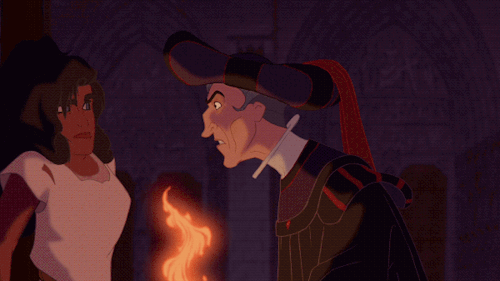
Our climax is accompanied by the best instrumental track in the film, Sanctuary! Whenever I hear this piece, I have to stay completely silent, drinking in every single line and note, so as to properly absorb its brilliance. The track has accompanied a lot of my writing in the past: it’s always helped me when I was writing a powerful, emotional climax, whether through the emotion it wrought from me or just from wanting to write a new scene to the music. This entire sequence, from a musical, writing, animation, and character point of view, is I think what made Disney decide to make this film in the first place. The pacing -- the character animation of Quasimodo tearing down the pillars -- the drawn backgrounds of Notre Dame -- the camera whirling over the never-ending crowd’s heads and up onto the cathedral as Quasimodo hoists Esmeralda over his head -- this is the heart of why the movie was made and what the entire film was building up to. This resistance against injustice and the protection of our sacred, historical institutions from hatred and cruelty is what Hunchback is and should be all about. Occasionally this battle scene is inter-spliced with comic bits that once again aren’t really necessary and kind of stick out (Laverne’s Wizard of Oz reference and Hugo’s impression of a fighter plane in particular are out of place), but it doesn’t ruin anything for me. Fortunately as the climax grows darker with the arrival of Frollo and the transition from Sanctuary! into And He Shall Smite the Wicked, the gargoyles take a backseat, and we get focus where we should’ve always had it: on Quasimodo, Esmeralda, and Frollo. Thanks to his love for his friend Esmeralda and the realization of his own self-worth, Quasimodo finally stands up to Frollo and breaks free of his poisonous influence once and for all. This line of Quasi’s has always stuck with me --
“All my life you’ve taught me the world is a dark, cruel place...but now I see the only thing dark and cruel about it is people like you!”

Even now this line is just so powerful. There was a point where all I saw of the world was its cruelties and injustices...but like Quasimodo, I’ve come to see that those cruelties are not inherent to the world or even to mankind as a whole. Humans are capable of both great evil and great good, but as long as the evil people of the world are allowed to seize control and exert their toxic influence over everyone else, the world and mankind overall will never become better. Like Quasimodo, we must stand against those who’ve embraced cruelty and hatred over acceptance and love. We must protect the brighter parts of the world that evil so wishes to snuff out. It’s a moral I think has only become more relevant and important over time.
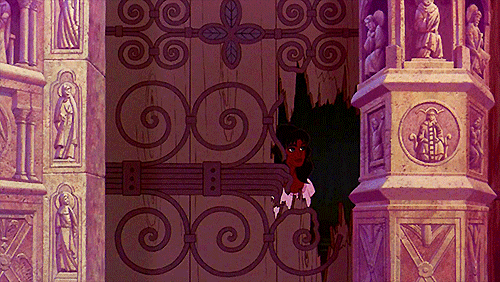
Unlike in the book and musical, Esmeralda survives, and as much as I’ve heard people try to argue Esmeralda living is not true to the spirit of the original novel, I think it really suits the story being told and really feels just for both characters. Quasimodo deserved happiness; Esmeralda deserved happiness; and most importantly, this all the more highlights how different Quasimodo is from Frollo. Frollo says to Esmeralda, “Choose me or the fire” -- basically, if he can’t have her, he doesn’t want anyone else to...but Quasimodo doesn’t think that way. He cherishes Esmeralda and her friendship without any caveats or conditions: therefore him losing Esmeralda, whether to Phoebus or to death, doesn’t prompt him to commit suicide like he did in the novel. It’s not only a more uplifting ending, but I think a lesson in the selflessness of love, even if it’s just platonic love. And because Esmeralda loves Quasimodo just as much as a friend, she leads him out into the sun, where he finds even more of the love he deserves from the city he wished so much to belong in. Quasimodo doesn’t get the girl, but that was never what he wanted in the first place: it was merely to be accepted as he was.
The Hunchback of Notre Dame was one of the most formative films of my childhood, right up there with Beauty and the Beast, The Prince of Egypt, and Anastasia, and it remains my second favorite Disney animated film of all time. With time, I’ve seen more and more of its flaws, but those flaws don’t ruin what in the end is one of the most daring, revolutionary projects Disney Animation has ever tackled. Its artistry, from the backgrounds to the character animation, is exceptional; all of its major human characters are multi-faceted, complex, and real; its themes are eternally relevant and powerful; and its score and nearly all of its songs are just through the stratosphere in their quality. Hunchback, along with Beauty and the Beast, made me fall in love with France from afar as a child, a love affair that has only become more and more intense through the years, and Quasimodo and Esmeralda even now are so close to my heart. I wish so much to be as kind and gentle as Quasimodo and as brave and noble as Esmeralda, and I can only hope that at some point, if I ever visit Disneyland Paris, I might finally meet them. The Hunchback of Notre Dame may not have gotten the appreciation it deserved when it first came to theaters, but I’ll always be happy to hear Disney fans remembering it as fondly as I do. Who knows? Maybe someday, the world will be wiser and will give this film its time in the sun at long last.

#d-views#disney reviews#the hunchback of notre dame#disney#opinion#analysis#reviews#oh boy here i go
18 notes
·
View notes
Note
Movie asks: 1, 6, 8, 9, 10, 13, 14, 22
EMILYYYYY. I love how you disappear for months on end and reappear just to ask me about my favourite movies (…and blog about Criminal Minds). Thank you, darling! *hugs*
1) Rank the major franchises (marvel, DC, Harry Potter, Star Wars, etc.)
Ugggh, it’s about the movies, not the books/comics, so:
DC, Marvel, Harry Potter. Star Wars.
If it was anything but Star Wars, Harry Potter would be last, because the later adaptations especially suck balls, but, with the notable exception of Rogue One, I just…cannot be bothered about SW oops.
6) If you were on a bus or airplane and in charge of picking the movie for everybody to watch, what would you pick?
Ooof, that’s a tough one. What’s a movie everyone likes? Hnng. The Sound of Music! Even people who don’t like it can probably sing along to all the songs
8) What is your favorite movie about an academic topic that you study or are interested in?
Ummm. My first thought was: Pick an Arthurian movie. But I don’t like any Arthurian movies. And then my treacherous brain whispered: Robin Hood is an “academic” interest too, so just say Disney’s Robin Hood. But that feels like cheating. And saying LOTR because of the OE/ON feels like cheating too? But I really can’t think of anything.
9) Real person or event that you’d like to see adapted into a movie?
Based on a tumblr post I saw recently, I’d love an adaptation of the RMS Carpathia!
10) Book, graphic novel, or play you’d like to see adapted into a movie?
If We Were Villains, because I just finished it, but I’m not done. I want MORE.
13) What do you like to eat when you see movies in the theater?
Ideally something that doesn’t make a lot of noise. So… chocolate?
14) What do you eat when you watch movies at home?
Crisps. And also chocolate.
22) What are your most rewatched movies?
Atonement, Enchanted, The Parent Trap, Ocean’s Eleven, The Sound of Music, Narnia: Prince Caspian, Tangled, Mr and Mrs Smith, Notting Hill, Zoop in Africa, Lang Leve de Koningin.
32 notes
·
View notes